Abstract
The cult of St George in the Eastern Mediterranean is one of the most extraordinary examples of cohabitation among different religious communities. For a long time, Greek Orthodox, Latins, and Muslims shared shrines dedicated to the Cappadocian warrior in very different places. This phenomenon touches on two aspects of the cult—the intercultural and the transcultural—that should be considered separately. My paper mainly focuses on the cross-cultural value of the cult and the iconography of St George in continental and insular Greece during the Latinokratia (13th–14th centuries). In this area, we face the same phenomenon with similar contradictions to those found in Turkey or Palestine, where George was shared by different communities, but could also serve to strengthen the identity of a particular ethnic group. Venetians, Franks, Genoese, Catalans, and Greeks (Ῥωμαῖοι) sought the protection of St George, and in this process, they tried to physically or figuratively appropriate his image. However, in order to gain a better understanding of the peculiar situation in Frankish-Palaiologian Greece, it is necessary first to analyze the use of images of St George by the Palaiologian dynasty (1261–1453). Later, we will consider this in relation to the cult and the depiction of the saint on a series of artworks and monuments in Frankish and Catalan Greece. The latter enables us to more precisely interrogate the significance of the former cult of St George in the Crown of Aragon and assess the consequences of the rulership of Greece for the flourishing of his iconography in Late Gothic art.
1. Saint George, a Saint for Cross-Cultural Studies
Parmi les saints de l’antiquité, nul n’a éclipsé la gloire de Saint Georges. Sa renommée s’est répandue dans toutes les parties du monde chrétien; l’Orient et l’Occident l’ont célébré avec enthousiasme.()
As is well known, the cult of St George in the Eastern Mediterranean is one of the most extraordinary examples of cohabitation among different religious communities (; ; ; ; ). For a long time, Greek Orthodox, Latins, or Muslims shared shrines dedicated to the Cappadocian warrior in very different places. This phenomenon touches on two aspects of the cult—the intercultural and the transcultural—that should be considered separately.
Although the use of these two terms can be puzzling, each has a precise meaning. When we say that the cult of St George is ‘intercultural’, we are referring to the capacity of the saint to blur religious and ethnic divisions within a particular area or society. As a result of this, celebrations of the saint became privileged spaces of interaction, in which different communities shared in his worship. That is therefore a phenomenon that is intercultural (or cross-cultural). It is common to multi-ethnic and multi-religious societies as are found in Palestine, Lebanon, Anatolia, or Latin Greece. However, the term ‘transcultural’ describes the specific ability of St George to cross religious and cultural borders and thereby acquire new features or annex to other figures. This metamorphosis or appropriation is usually linked to the movement of populations, particularly in campaigns of conquest, and occurs in frontier lands such as the Crusader States, Seljuk Anatolia, or Frankish Greece. As such, both terms relate to cross-cultural studies and can simultaneously apply to a single case. While the first—intercultural—stresses the idea of cultural convergence around worship, the second—transcultural—refers to the faculty of the saint to migrate across regions, ethnicities and religions and take on a new significance or new properties.
On the one hand, as an example of intercultural worship, I will single out the case the case of Lod (Israel), the former Lydda, close to Tel Aviv. According to legend (Greek Acta), having been born in Cappadocia, after the death of his father, George came during his childhood to Lydda—the ancient Diospolis—which was the birthplace of his mother. Subsequently, following his martyrdom in Nicomedia (Asia Minor), certain pilgrimage accounts indicate that his remains were moved to Lydda, the alleged place of his burial and even martyrdom (Theodosius, about 530), where numerous miracles occurred (; ; ; ; ; ; ; ; ). The current Greek Orthodox church in Lod, which was built in 1870 above an earlier church, shares space with an attached Muslim mosque that is also associated with the cult of St George.1 One of the most striking examples of a shared sanctuary is the festival of St George in the church of Aya Yorgi in the island of Büyükada, in Istanbul. Every 23rd of April the place receives a flood of pilgrims, both Christian and Muslim, who celebrate there the arrival of Spring ().
On the other hand, the image of George as warrior and dragon-slayer possesses a special transcultural ability to cross religious and cultural borders where might then be annexed to other figures. Thus, in Anatolia, Lebanon, Syria, and Palestine, Saint George became the Muslim saint al-Khidr (; ; ; ; ; ). This Muslim saint is a divine character who is mentioned in the Koran (18, 60–82) accompanying Moses, and whose special day was celebrated on 23th April when he is invoked as the protector of travellers, navigation, and vegetation. Since the battle of Manzikert in 1071 and the subsequent Seljuk occupation of Anatolia, the image of the Muslim hero al-Khidr is assimilated to that of St George the Cappadocian, and decorated amulets, coins, and lamps.
Although the holy warrior of Cappadocia2 went on to be painted in Orthodox churches as before, there were occasions in which this depiction acquired a distinctive significance under the new Muslim rule. Thus, the new monastic cave-church dedicated to St George (Kirk Dam Alti Kilise or St. George at Belisirma), built between 1284 and 1295, in the Ihlara Valley. There, the Christian donors, the emir Basil Giagoupes, and his wife, the kyra Thamar, who were administrators of the region, are depicted flanking a standing and monumental St George (Figure 1). The Greek inscription informs us that this was made under the rule of the Seljuk Sultan Mesud II (1284–1297 and 1303–1307) and the Byzantine emperor, Andronikos II Palaiologos (1282–1328), who was no longer the ruler of this land but gave support to Mesud II to take the sultanate’s throne at Konya (; ; ; ; ; ; ).3 So, it is very likely that in this particular case, the presence of St George and the invocation to the Byzantine emperor were, on the one hand, a way of expressing and strengthening the “Byzantine” identity of the Orthodox Greek community—who were here outside the Byzantine state and within the Muslim Sultanate of Rum. On the other hand, the dual mention of the Sultan of Rum and the emperor is also a way to reinforce the bond between Greeks and Muslims in the context of alliances between Andronico II and Mesud II.
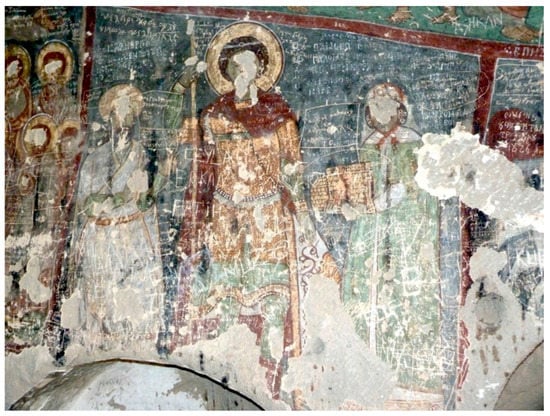
Figure 1.
St George between Emir Basil Giagoupes and his wife, kyra Thamar. Kirk Dam Alti Kilise or St George at Belisirma, Ihlara Valley (Cappadocia, Turkey), 1284–1295. © Author.
Notwithstanding the above, my paper focuses on the cross-cultural value of the cult and iconography of St George in another geographical area, that of Greece during the Latinokratia (13th–14th centuries).4 Here we confront a similar phenomenon where the contradictions are the same as those found in Turkey or Palestine, in which George is not only shared by different communities but also serves to strengthen the identity of a particular ethnic group.5 However, in Frankish Greece we are faced with exclusively Christian communities—Latin and Greek—who are fighting or praying for the same saint in a very specific context of war or peace. In each case the military dimension prevails and the object of devotion remains the Cappadocian warrior in his role as protector of the armies. Nonetheless, it is true that in the turbulent context of the Latinokratia, every ‘nation’ or ‘ethnic group’ tried to appropriate the image of St George because of the talismanic and charismatic power of the saint. Thus, this particular ‘struggle for St George’ became a mirror of the hostilities that ravaged Greece from the 13th to 15th centuries, in which, as we will see, St George was the image par excellence of the two principal contenders: the Byzantines and the Crusaders.
Despite the enmity, nothing prevents the rise of the transcultural and intercultural aspect of the cult of St George in this area, in which the encounter between Latins and Greeks entails an exchange of motifs, a flow of relics, and the creation of shared sanctuaries. Furthermore, in some cases, a double-echo effect transformed perception of the saint both in the Crusader States in Greece and in the Latin metropolis. This is particularly interesting in lands ruled by the Crown of Aragon, in which it is possible to determine a cause-and-effect process running in both directions. This phenomenon precedes and announces what Natasha Eaton has defined for the art of colonialism as ‘mimesis in flux’ (). The Crusading spirit that dominated the expansion of the Kingdom of Aragon in the 13th century resulted in an emerging cult, and the patronage of an exotic St George, in direct relation to the chivalric ideals of kingship. The 14th-century military feats of Catalan mercenaries in Anatolia and Greece fuelled this role of St George as protector of the armies and was accompanied by an increasing mythification of the saint as symbol of a collective identity of the communities that settled in newly conquered lands in both Iberia and Greece.
2. Saint George in Frankish-Palaiologan Greece
(…) let’s not forget that the whole Greece is, in many respects, a frontier.()
After the Crusader sack of Constantinople in 1204, and the establishment of the ephemeral Latin Empire, the former Byzantine lands of Greece were divided among Venetians, Franks, Genoese, and Greeks (Ῥωμαῖοι: Rhomaioi), to whom the Catalans were added in the 14th century (). All of these groups sought the protection of St George and in this process, they tried to physically or figuratively appropriate his image. For instance, a couple of reliefs depicting St Demetrios (Byzantine spolium) and St George (13th-century slab), in their role as patrons of the Venetian army and guardians of the Ducal Palace, were included in the 13th-century façade of the basilica of St Mark in Venice some decades after the looting of Constantinople (Figure 2a). According to David M. Perry, the display of these carvings shows how “eastern Mediterranean Christian militarism had been appropriated by Venice” in pursuit of the idea of translatio imperii (). Likewise, the no less ambitious republic of Genoa, did not hesitate around 1312 to commission a painter from Constantinople (Marcus) to execute a monumental mural painting of the city patron, St George, in the renewed cathedral of Genoa () (Figure 2b). In both cases, the use of St George can be seen either as an appropriation or a self-identification with Byzantium. It should not be forgotten that these two maritime republics were flighting during this period, using different strategies, to play the role of Byzantium in the Eastern Mediterranean.
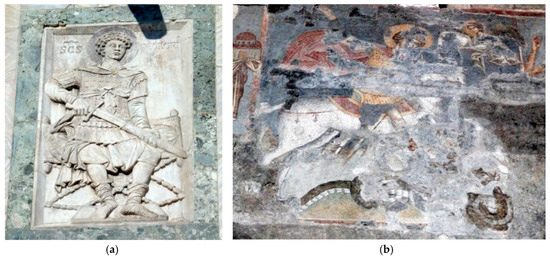
Figure 2.
(a) St George. Façade of the basilica of Saint Mark in Venice, 13th century. © Author “per gentile concessione della Procuratoria di San Marco”. (b) Marcus (?), St George horsing and slaying the Dragon. Cathedral of Genoa, north aisle, ca. 1312. © Author.
The most compelling example of this interaction between the two sides of the Mediterranean in relation to the cult of St George is the Atlas-Portolano made by Petrus Vesconte in Venice (Lyon, Ms. 175. F. 7–8) (, Table IV) (Figure 3). This map shows the new Latin perception of the sacred geography of the Mediterranean in the aftermath of the sack of Constantinople; the establishment of Crusader States in the former territories of the Byzantine Empire; and the expansion of the Mendicant Orders in the Levant. Here, saints are arranged across different areas of a map. It is no coincidence that St Francis and St George were depicted in the Eastern Mediterranean, at just the moment that the Franciscans were expanding in the Holy Land (), Constantinople and Greece, and at a time when the cult of St George was increasingly diffused among Latins and Greeks (; ). However, in a sense, the depiction of George standing, following the Byzantine iconography, should be interpreted as an attempt to geographically identify the Cappadocian saint with the heritage of the Eastern Roman Empire. This was an issue of permanent concern by the different leading trade powers in the Mediterranean.
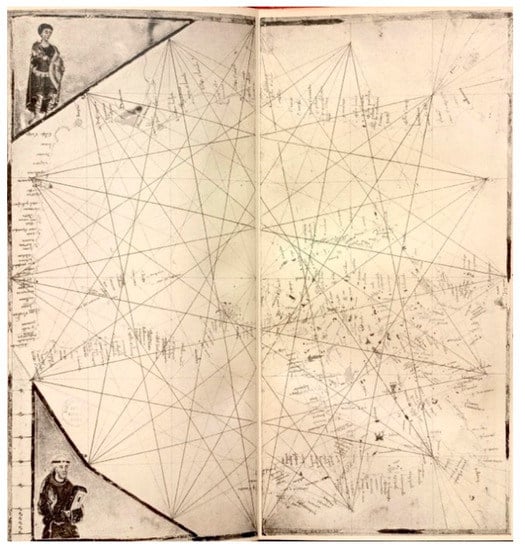
Figure 3.
St George and St Francis in the Atlas-Portolano of Petrus Vesconte, Venice, 1319. Lyon, Ms. 175. F. 7–8. Source: (, Table IV).
2.1. Saint George in the Byzantine Empire: Komnenian and Palaiologan Uses
However, in order to gain a better understanding of the peculiar situation in Frankish-Palaiologian Greece, it is necessary first to analyze the use of images of St George by the Palaiologian dynasty (1261–1453). Although the Cappadocian warrior had enjoyed great success as a military saint in the art of frontier lands and had been identified as the protector of the upper ranks of the Byzantine army, with the reconquest of Constantinople by the Palaiologoi his figure becomes even more present. The precarious situation of the Late Byzantine Empire, surrounded and besieged by all on its borders, gave particular prominence to the iconography of George as a reference mark and keeper of Greek interests. Once we know this, we can cross-check it against the cult and depiction of the saint in the Frankish, Genoese and Catalan Greece.
It is well known that the wide diffusion of the depiction of St George during the Palaiologan dynasty is related to his singular role as military saint. Since the 10th century George had been the patron saint of the army, generals, and powerful families around the emperor (; ). He was depicted either standing, wearing the lorica segmentata (segmented cuirass) as a Roman soldier, or riding a horse (; ; ). This association is underscored by his depiction in the monastic church of Panagia Phorbiotissa at Asinou (Cyprus), in which George wears a luxury diadem (stemmatogyrion) characteristic of the Imperial Palace guard from the 11th century (Figure 4a,b). The inscription informs us that this is a votive image commissioned by Nicephoros, a horse-breeder, in honor of the megalomartyr Γεώργιος. The painting is in the narthex, between the East and West entrances to this space, in order to underline the apotropaic role of the saint as was common in Byzantine painted churches ().
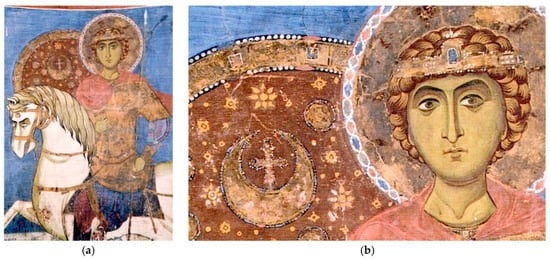
Figure 4.
St George horsing. Panagia Phorbiotissa at Asinou (Cyrpus), narthex, south conch, end of the 12th century. (a) Detail of St George. (b) Detail of the shield with the Crescent Moon crowned by a cross and encircled by three stars. © Used with permission of Ángel Bartolomé.
Having been made when the island was under Latin rule at the end of the 12th century (after 1191–1192), the image of St George at Asinou was intended to be seen as Byzantine and could be distinguished from other equestrian images of St George used by the Crusaders. This explains motifs such as the genuine diadem or the very peculiar heraldic shield with the Crescent Moon crowned by a cross and encircled by three stars. It is likely that the heraldic shield was a Byzantine invention in response to Latin heraldry (). Although Byzantines had no tradition of a coat of arms, the appearance of Crusaders in their former lands encouraged the use of heraldry in certain images. Thus, in Asinou, George is wearing a bizarre blazon. It happens at other sites in the 13th-century Peloponnese, in lands such as the Despotate of Morea that had been recently reconquered by Byzantines from Latin hands, such as Hagios Ioannis Chrysostomos at Geraki, where the saint also protects the door (Figure 5a). As Andreas and Judith Stylianou highlighted, both shields are round ‘peltas’ as is characteristic of the Byzantine army. Latin shields are usually kite-shaped or triangular. However, the most striking motif is that of the Crescent Moon crowned by a cross and a star. This emblem was employed on Imperial coins, especially under Alexis Komnenos, and derives from Roman coins of the former city of Byzantium, as protected by the goddess Artemis (Moon) (; ; , n. 421, and 249). (Figure 5b)
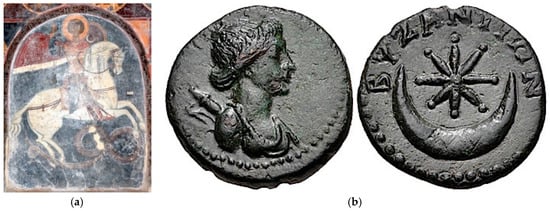
Figure 5.
(a) St George. Hagios Ioannis Chrysostomos at Geraki, c.1300. © Used with permission of the Ephorate of Antiquities of Lakonia, Hellenic Ministry of Culture and Sports/Archaeological Resources Fund. (b) Roman coin of the former city of Byzantium, with bust of Artemis on the anverse and an eight-rayed star with a crescent in the reverse, 1st century. Source: Wikipedia commons (Star and Crescent).
Nevertheless, the use of this primitive emblem on St George’s shield can be connected with another tradition: That of the Roman legionary shield devices, which have been preserved in early modern copies of the Notitia Dignitatum. Illustrations in this text, originally composed in the middle of the 6th century, provide us with compelling comparisons to the blazons depicted in Asinou and Geraki. I am referring to the Insignia viri illustris militum per Thracia, in which Pannoniciai iunores and Tzaani have a shield with the crescent and the stars (Notitia Dignitatum VIII, pp. 16–17, Oxford, Bodleian Library, Canon Misc. 378, f. 94v; ) (Figure 6). It is no coincidence that these ancient insignia with the crescent and the stars are attributed to the army in Thrace, the Roman province to which the city of Constantinople belongs. I therefore wonder if the choice of this blazon for equestrian depictions of St George in the Komnenian and Palaiologian period mirror an interest in bringing prestige to the Byzantine warrior by linking his shield to the ancient Roman army in Thrace.
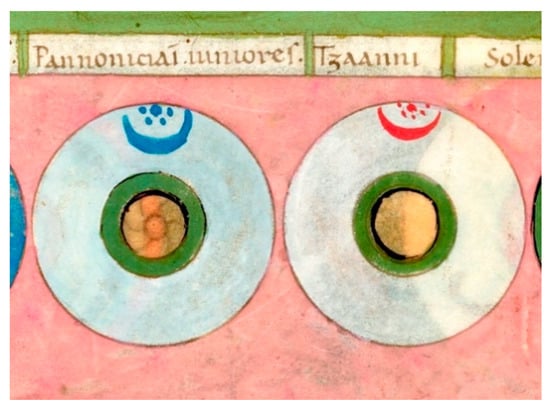
Figure 6.
Notitia Dignitatum VIII, 16–17, Oxford, Bodleian Library, Canon Misc. 378, f. 94v, Basel, 1436. © Used with permission of the Bodleian Libraries, University of Oxford.
The most eloquent demonstration of the importance of St George and the use of insignia related to him in the Palaiologan court is provided by the Book of Ceremonies of the Imperial Palace, known as Pseudo-Kodinos (1341–1353). During the celebration of the ceremony of the Prokypsis at Christmas, Epiphany, and Palm Sunday in the courtyard of the Blachernai Palace, the emperor mounted a wooden podium (πρόκυψις) to be acclaimed.6 During this performance, the emperor was accompanied by a procession consisting of the chiefs of the army (sebastokrator, podestás) and the Imperial Guard waving seven banners and standards, among which were an equestrian image of St George and the Octopus (the eight-pointed star of Manuel I Komnenos) as well as a banner featuring a metal dragon. It is not by chance that this ceremony in the courtyard was performed right in front of the chapel of the Theotokos Nikopoios, whose exterior was decorated with a monumental mural icon depicting St George (; ; ; ).
It is also worth mentioning that the cult of the saint was reactivated during the Palaiologan restoration of the Byzantine Empire in Constantinople. According to Nicephorus Gregoras (I, 303, 11–308, 22), the last Latin emperor, Baldwin II (1228–1261), heard St George’s horse neighing on the eve of the conquest of the city by Michel VIII Palaeologus (, n. 22). It is very likely that this and other victories of Michel VIII over the Latins promoted the spread of the cult of St George, particularly in northwestern Greece after the battle of Pelagonia (1259).7 This should explain the unusual setting of a colossal wooden statue or xoanon of St George (almost 3 mts. high) in the church of Hagios Georgios in Omorfokklisia (ancient Kalista or Galista), close to Kastoria, in northwestern Macedonia (Figure 7a,b) Although this colossus has been dated to 1286–1287 after a painted dedicatory inscription in the church, its actual date is uncertain. Most scholars think that the epigraph was repainted and is later than the interior painted decoration. In the inscription are mentioned the brothers kyr Nichephoros, John, and Andronikos from the noble family of Netzades, along with the names of the family of Andronikos II (1282–1328). Paradoxically, the same members of Netzades family (with Jacob instead of John) along with the names of Andronikos II’s family are mentioned in another inscription with the date 1255 in the nearby church of Taxiarches in Tsouka (). Thus, it is likely that this represents a damnatio memorie, in which the original names of the rulers were replaced. As the paintings in Omorphoklisia seem to date from the period of Byzantine domination over the region after the battle of Pelagonia (1259), the name of the original ruler erased in the inscription might have been Michael VIII (1261–1282), who was responsible for the failed and therefore controversial Union of the Churches (; ).
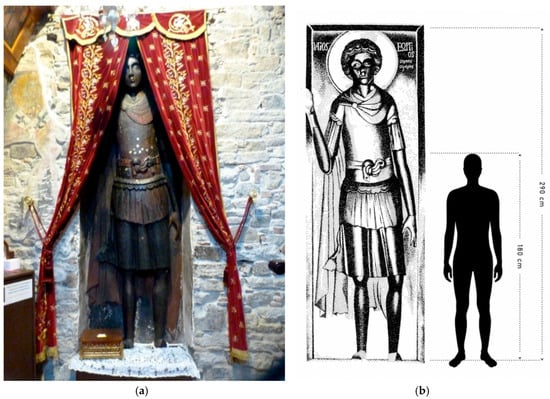
Figure 7.
Colossal wooden icon of St George, c.1261–1282. Hagios Georgios in Omorfokklisia ancient Galitsa), Kastoria (Macedonia, Greece). (a) General view of the wooden icon of St George. © Author (b) Drawing of the wooden icon of St George in relation to human scale © Used with permission of Iker Spozio.
This monumental wooden sculpture has been related to other examples of the same period located in the diocese of the archbishop of Ohrid (i.e., statue of St Clement from Ohrid) (; ; ; ; ), to which the bishop of Kastoria belonged. Notwithstanding this, the particular features of this colossus have led some scholars to consider Constantinople as the original place of production (). Both its monumental format and the use of round relief were probably intended as a reference to the ancient public statues of Constantinople, most of them related to the memory of Constantine in the Middle Ages (). It is no coincidence that Michael VIII, acclaimed in text and image as the New Constantine (), also promoted this tradition of celebratory statues by erecting a statue on a bronze column in front of Hagioi Apostoli.8 This consisted of a monumental figure of St Michael with the emperor at his feet offering up the city of Constantinople. In my opinion, the colossal image of St George in Kastoria—and probably the now lost statue of George from the village of Nestorio (Kastoria) (2.15 m. tall) (; Τσιγαριδας, p. 92)—should be related to this revival of monumental statuary during the first Palaiologan period in Constantinople (cf. ) and the renewed cult of the saint in the capital, where the emperor restored the Orthodox rite in the famous sanctuary of the monastery of St George in Manganas (). Indeed, the face of the colossus is reminiscent of the Theodosian style, and indicates possible production in a Constantinopolitan workshop.
It is worth recalling that Kastoria occupied a strategic position in the period of Michael VIII. It acted as a stronghold to control a frontier area only recently recovered by the Byzantine Empire after the battle of Pelagonia. Besides, the city was an important artistic and trade center, where educated officials and army members lived. This would explain the numerous depictions of military saints in its churches, especially those of St George, in his role as patron saint of the army, in wall paintings, icons, and sculptures in the round. It is likely that these extraordinary and uncommon 13th-century Palaiologan colossal statues of St George were then perceived by both the local population and Byzantine host as talismans or protectors for this recently recovered area. These giants—in the role of Byzantine icons—might have been perceived by the viewer as types of living being who were able to act and perform wonders in favor of the faithful. Using C. Stephen Jaeger’s terminology, we are before genuine charismatic works of art, whose strength and potential to effect events exceed those of simple objects (). Ultimately, these depictions of a huge standing St George may also be considered as a Byzantine response to the Latins, who were expelled from Constantinople in 1261 by Michael VIII Palaeologus but continued in their Greek lands to appropriate the image and relics of St George.
2.2. Saint George in the Frankokratia: Exchanges and Cultural Identities
In the Latin Peloponnesus (Principality of Achaea or Morea and the Duchy of Athens), the wide dissemination of the depiction of the saint in 13th- and 14th-century art favoured the equestrian type killing the dragon rather than George as a standing figure. In most of these, George bears an oblong shield, which is characteristic of Latin warriors. This is often decorated with a blazon consisting of the Cross of St George. This symbol was actually borrowed from the Latin iconography of St George developed by Crusaders following the apparition of the saint during the capture of Antioch in 1098.9 The paintings of the Frankish gatehouse at Nauplio, in the Duchy of Athens (1291–1311), provide a paradigmatic example of this: The common Byzantine round shield of St George is decorated inside by an oblong blazon depicting a red cross on a white background, that is the Cross of the Crusaders (Figure 8). Moreover, the saint is standing up on his spurs, as Crusader warriors did (; , Figure 8).
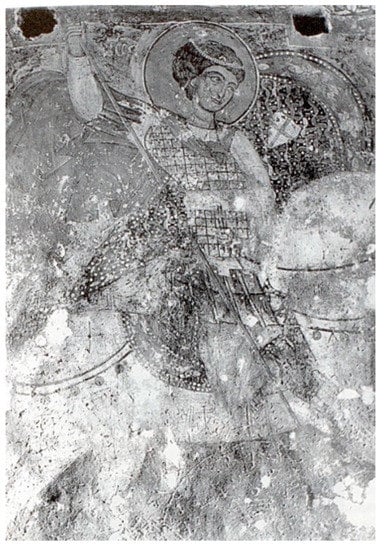
Figure 8.
St George. Paintings in the Frankish gatehouse at Nauplio, ca. 1291–1311. Source: ().
The aim of this Latinization of the Byzantine iconography of St George in Greece was to distinguish the depictions produced for the Franks, especially when they were made by Greek painters, and strengthen the cohesion among the Frankish population in Morea. As heirs to the Crusaders, the Latins wanted to emphasize their divine role in the Peloponnesus by invoking the same saint that protected the Crusaders in the conquest of Antioch and Jerusalem.10 It is worth noting that defeat of Pelagonia was a blow to Frankish pride in Greece, as William of Villehardouin, prince of Achaea (1246–1278), was captured by the Byzantines and later released (1262) on condition that he handed over the strongholds of Monemvasia, Maina, and Mistra to Emperor Michael VIII (). However, one year after William’s liberation, in 1263, the Franks were able to defeat the Byzantine army in Prinitza (near ancient Olympia), and thereby preserve their possession of Andravida, the capital of the Principality of Achaea. It is not a coincidence that in a 14th-century account glorifying the family Villehardouin—the Greek version of the Chronicle of Morea (ca. 1320)—a white knight appears riding his horse during this battle to lead the Frankish host (“εἶδαν καὶ ἐμαρτύρησαν ὅτι εἶδαν καβαλλάρην ἀσπραλογᾶτον εἰς φαρί, γυμνὸν σπαθὶν ἐβάστα, καὶ πάντα ὑπήγαινεν ὀμπρὸς ἐκεῖ ποῦ ἦσαν οἱ Φράγκοι”), who was identified as Saint George (). Thus, the very same saint who was widely celebrated by the Palaiologoi in Macedonia, was also acting as a reliable protector of the Latins in Morea—performing miraculous deeds in battle that reminded them of those carried out by George for the Crusader army in the Holy Land.
As () and Monika () pointed out, this shared patronage of St George between foes provoked an exchange of iconographic and heraldic motifs in his imagery. Ultimately, Latin and Greeks shared the chivalric ideals embodied by St George. This explains, for example, the fact that in Hagios Ioannis Chrysostomos at Geraki, the saint was depicted around 1300 bearing a Latin oblong shield (Figure 5a). Although, from 1261 Geraki was under Byzantine rule, they chose the Crusader-like equestrian type of St George to invoke his role as protector. Notwithstanding this, they did not hesitate to include the above-mentioned motif of the crescent to mark his unquestionable Byzantine allegiance. As a result, most of the depictions of St George in Byzantine and Latin Greece during the Latinokratia period should be seen as a game or chain of responses: If colossal standing Georges challenged equestrian Crusader knights in Macedonia, Georges on horseback in a shared Peloponnese acted as a mirror-image for both communities. The goal of these exchanges was not only to highlight the military and apotropaic character of the saint but also create an identification between George and their respective audiences.
As previously noted, the practice of heraldry was alien to Byzantine culture, where arms were simply reduced to the Imperial Insignia. Thus, the display of arms by some of the Latins in the Eastern states was a genuine sign of appropriation. This gained special relevance when the coats of arms were associated with major transcultural saints such as Saint George, mega-martyr par excellence and patron of the Byzantine, Catalan, Venetian, and Genoese armies. For this reason, I am particularly intrigued by an object kept in the Byzantine and Christian Museum in Athens—a wooden-relief Vita icon of Saint George (107 cm × 72 cm), in which the saint displays what seems to be a Latin coat of arms (Figure 9a,b). This detail has been dismissed by scholarship as a mere imitation of the Frankish shields. Furthermore, in this depiction, the saint does not wear the common muscled or lamellar cuirass of Byzantine warriors but is dressed in Latin clothes and chlamys ().
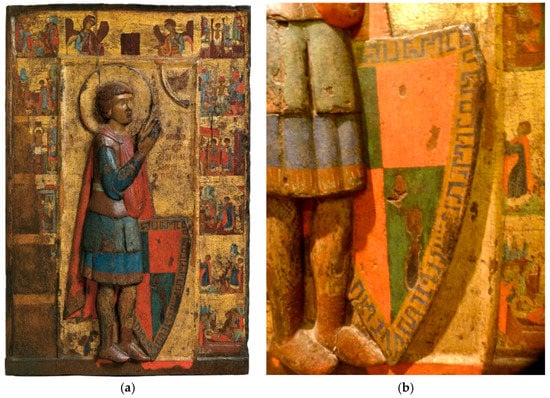
Figure 9.
Bilateral wooden-relief Vita icon of St George, Kastoria (Macedonia, Greece), second half of the 13th century. Byzantine and Christian Museum, Athens, BXM 1108. (a) General view of the side A of this bilateral icon: St George and his hagiographical cycle. Source: () (b) Detail of the side A of this bilateral icon: Shield of St George. © Author.
On the basis of comparisons with other icon-wooden reliefs, the piece has often been ascribed to the region of Kastoria, in Northern Greece (, II, p. 156). In fact, the icon came from the church of Hagia Paraskevi in Kastoria and has been dated to the second half of the 13th century (; ). For some scholars, its hybrid character, which was defined as Byzantine-Gothic, had its sources in the Despotate of Epiros, in the sculpture of the impressive Panagia Paragoritissa (around 1290) (; ; ). Notwithstanding this, in a pioneering study, G. A. Sotiriou did not hesitate to attribute the artwork to Constantinople, by invoking the high quality of the painted cycle of the passion of St George framing the high relief (). The existence of another wooden Vita icon depicting a standing and beardless St. George in the National Art Museum of Kiev, which came from Kherson and dated to the 12th century, pointed to a similar origin (; ) (Figure 10a). Indeed, in both icons, a relief of a standing St George presides the panel and is surrounded by a rectangular frame depicting his passion.
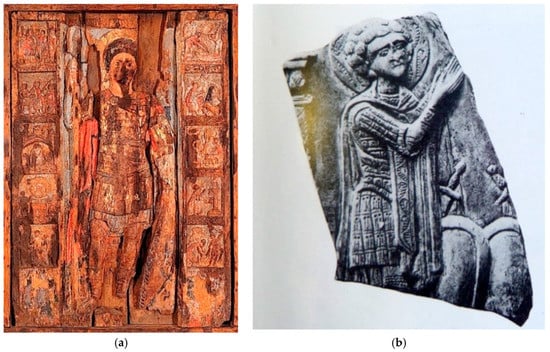
Figure 10.
(a) Wooden Vita icon of St George, Constantinople, 12th c. (?). National Art Museum of Ukraine, Kiev. © With permission of the National Museum of Ukraine (Kyiv, Ukraine). (b) Fragmentary 12th-century steatite icon depicting St George praying, Constantinople (?), 12th c. Kiev, Museum of Western and Oriental Art. Source: ().
Notwithstanding this, the Kastoria relief has the saint in a slightly different pose from that from Kiev. St George is now depicted in a three-quarter view, arising and folding his hands, in the act of praying to Christ. This gesture refers back to a specific group of 11th- and 12th-century icons made in steatite, which depict the standing warrior saints George and Theodore. As A. N. Tsigaridas pointed out the most convincing precedent for the St George from Kastoria is a fragmentary 12th-century steatite icon kept in Kiev (Museum of Western and Oriental Art) (, n. 25, p. 1169), in which a very similar beardless and curly-haired saint is shown in the act of praying next to his shield () (Figure 10b). Here, George raises his gaze towards the now-missing upper right section of the icon, in which there was probably a bust of Christ about to crown him. In Kastoria this part is occupied by Christ, who extends his arms to the praying saint from the arc of heaven. It is worth emphasizing that steatite icons were widespread across the Byzantine geography of private devotion (). From one perspective, it might be deduced that a piece like the the Kiev icon could have been used as a model by a local workshop to produce the wooden-relief kept in the Byzantine and Christian Museum in Athens. However, on the other hand, the monumental size and quality of the painted cycle point to production in Constantinople. Once again, this relief-icon could be a wooden representative of the renewal of sculpture associated with the Palaiologoi in the capital through the 13th century.
However, everything about this piece is puzzling, and for decades this extraordinary artwork has raised questions that led scholars to propose very different places for its production; Constantinople, Kastoria, the Latin Kingdom of Thessaloniki (1204–1223), Cyprus, and Epiros. Even the name of Irene Doukina Angelina Komnena, widow of the Bulgarian Tsar Ivan II Assen, has been related to the icon during her period of regency (1246–1253) by identifying her as the mourning woman depicted in proskynesis at the feet of St George.11 The icon also caught the attention of Hans Belting who considered it an outstanding product of the 13th-century art of the Mediterranean commonwealth, whose lingua franca was characterized by a hybridization of styles and forms in which the categories of Western and Eastern were blurred (Belting 1982).12 In an attempt to continue along this path, I have been wondering about the very specific coat of arms that decorates the triangular shield next to St George (Figure 9b,) and which has been usually disregarded by scholars. In an earlier publication (), I identified this blazon as belonging to the Genoese family of the Zaccaria, “écartelé d’argent et de gueules” (quartered in silver and red), who were Lords of Focea (1267?–1340) and Chios (1304–1329), and vassals of the Byzantine emperor (). More specifically, I felt emboldened to propose that this wooden icon could be a tribute to their most important member, Benedetto Zaccaria, Lord of Focea and Chios (+1307), who also was a celebrated admiral in the army of Michael VIII and Imperial ambassador in the West in 1282 (; ). What is more, it is very likely that to reinforce this bond with Byzantium and especially with Michael VIII, Benedetto married a member of the Imperial Family—a Paleologina—as we can deduce from the fact that he named his son and successor Paleologo (+1314) (; ). This hypothesis allowed me to suggest that the controversial wooden-relief icon had been made in Constantinople around 1307, the date of Benedetto’s death, by commission of his wife, who, kneeling, is depicted at the foot of Saint George. The pseudo-Kufic decoration of the edge of the shield seemed, at least in the first instance, to reinforce my thesis, because this kind of motif can be found in artworks that relate to the idea of victory over Islam. It worth noting that the fiefs of Focea and Chios were respectively given by Michael VIII and his son Andronico II to Zaccaria in order to protect the coast of Asia Minor from the threat of the Turks (). Ultimately, the production and cult of such an icon might have helped to foster closer ties between the Genoese and Greek population—as a palladium for the protection of the island and its trade ().
However, the addition of Islamic motifs to a Byzantine artwork could be due to other reasons, especially if the icon is dated earlier, to the second half of the 13th century, in the context of fluid relations between the Byzantine rulers and the Seljuk states in Anatolia. In this case, as happened in other instances, the pseudo-Kufic decoration of its edge should be seen as no more than a symbol of high status that would evoke the luxury of the Seljuk carpets and precious objects so admired by the highest ranks of the Byzantine Empire ().
In fact, a more detailed analysis of the circumstances surrounding the piece has led me to discard my earlier hypothesis. First, there is no doubt about its provenance from Kastoria and liturgical function in the church of Hagia Paraskevi (, note 28). Second, the alleged Zaccaria shield seems to be a vague evocation of the Latin use of heraldry by the Byzantines. It is true that Martin and Benedetto II Zaccaria used a very similar coat of arms in the coins issued during their rulership in Chios (1319–1329) (, p. 413, illustration XIV,1) (Figure 11b). However, the distribution of colors in the shield of the icon does not correspond exactly to coeval illustrations as shown in the in the portolan of Angelico Dalorto dated to 1325—Florence, Corsini Collection—in which the Zaccaria’s banner marking the port of Focea (Foca) shows a reversed setting of red and silver () (Figure 11a).

Figure 11.
Coat of arms of the Genoese family the Zaccaria in Chios. (a) Banner of the family Zaccaria marking the port of Focea (Foca), Angelico Dalorto’s Portolano, Genoa, 1325. Florence, Corsini Collection. Source: (). (b) Coin of Martin and Benedetto II Zaccaria in Chios (1319–1329). Source: ().
The icon from Kastoria provides an example of the Byzantine fascination for the use of coats of arms in Latin chivalry in the context of the turmoil of the 13th-century Greece (). As such, the artwork should be understood as a kind of appropriation of enemy fashion on the part of the Byzantines, just as the Latins had done with the Byzantine iconography of St Georges. Besides the attire and the blazon, everything in the icon is genuinely Byzantine. If the type and posture of the praying saint derives from the steatite icons, the inscription accompanying the figure on both sides -’O AΓΙOΣ ΓΕΩΡΓΙOΣ Ό ΚAΠΠAΔOΚHΣ- suggests that the iconographer (painter) was familiar with the Byzantine vitae of George. In fact, from the 7th-century George was recurrently named in the hagiographies with the gentilic: Γεώργιος ο Καππαδόκης (; ). Moreover, the inclusion in the cycle of two episodes related to Empress and Saint Alexandra, Diocletian’s wife, is worth highlighting: The conversion (Figure 12b) and the sentencing of the saint and Alexandra (). In my opinion, this conveys not only a knowledge of the 10th-century rhetorical vitae written by Theodore Daphnopates and Symeon Metaphrastes but also some familiarity with the Synaxarium Ecclesiae Constantinopolitanae, which celebrates her feast on 21 April (, cols. 619–20; ; ). Insistence on the prayer of St George, which was depicted twice, in the scene of the beheading on the right side and in the central image relief of the saint, should be also seen as a transposition into images of his last invocation to God before his death as is contained in the rhetorical version of Theodore Daphnopates: “Κύριε ό θεός μου, (…)” ().
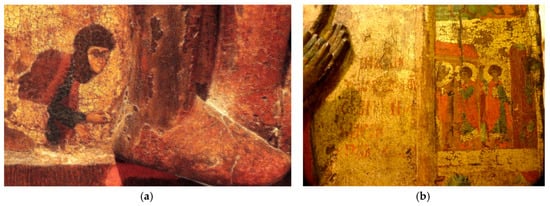
Figure 12.
Bilateral wooden-relief Vita icon of St George, Kastoria, second half of the 13th century. Byzantine and Christian Museum, Athens, BXM 1108. (a) Kneeling widow at the feet of St George. (b) Conversion of Alexandra. © Author.
As Nancy Sevcenko pointed out it is very likely that the lady who is depicted at the feet on St George commissioned the icon on behalf of her dead husband (Figure 12a). This would explain the insistence of the composition on the idea of a double intercession before the saint (mourning widow) and God (warrior George) ().13 Thereby, the relief should be perceived as an allusion to the occupation of the deceased: Perhaps some high-ranking member of the Byzantine army, who was established in the stronghold of Kastoria in the years after the victory of Pelagonia. Local production of the icon seems confirmed by the formal composition that that can be perceived as a reference to the colossal and talismanic statues of George scattered in this area. However, we will never know why they decided to update the attire and shield of the saint warrior in order to convert it into a Byzantine solider disguised as a Latin. To show their fascination for Latin chivalry and its customs? Or perhaps to express support for the policy of Michael VIII in his approaching to the West after the Council of Lyon for the Union of the Churches in 1274?
2.3. Saint George under Catalan Rule
This paradoxical process of the affirmation of group identity and iconographic hybridity is equally seen in the 14th-century Catalan domains in Greece. By this, I am referring to the cases of Hagios Georgios in Afkraifnio (Karditsa, Thessaly) and the Castle of Livadia (Boeotia) in Central Greece, along with those of Hagios Georgios Katholikos (Paliachora) and Hagios Nikolaos Mavrikas, on the island of Aegina. In all of them, St George was a focus of expectation as the guarantor of community protection.
During the outstanding 14th-century expansion of the Kingdom of Aragon, the Catalans occupied extensive portions of Greece, namely the Duchies of Athens and Neopatria (1311–1388) and the island of Aegina (1317–1451) (Figure 13a,b).14 This brought significant numbers of people from Catalonia and Aragon into contact with Byzantium. As the Franks did it before, the Catalans, once settled in Greece, were also capable of developing a cross-cultural society. It should, however, be noted that there are significant differences between the social background of the Catalans who settled in Greece, usually referred to as ‘Almogàvers’, and that of the noble Frankish knights. First, they were predominantly an army of mercenaries whose origins can be traced back to the military campaigns of the Kingdom of Aragon in the 13th century which succeeded in conquering the Muslims realms of Mallorca and Valencia. Second, among them there were Muslim warriors (). They belonged thus to the multicultural society that characterized the Spanish kingdoms in the Middle Ages, in which shared sanctuaries and mixed marriages were tolerated (). This meant that after the nomadic period of military campaigns and savage ravages in Anatolia and Greece (1303–1311), once they became settlers their modus operandi might be slightly more open than that of the Franks to the local population.15
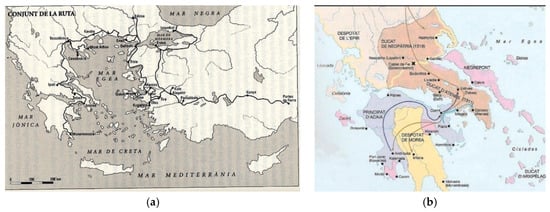
Figure 13.
The Catalans in Greece and Anatolia. (a) Itinerary of the Grand Catalan Company (Almogàvers) (1303–1311). Source: () (b) Catalan Greece in 14th century: Duchies of Athens and Neopatras. Source: ().
This cross-cultural society especially developed in the countryside and peripherical areas, even though they promoted or attended the orthodox liturgy of the Greeks.16 In some cases, the monuments display inscriptions in Greek celebrating the Latin donor or ruler. These public texts along with the choice of images decorating the walls played a major role in the developing of this intercultural process, whose aim is to blur religious and ethnic frontiers and make churches space of interaction.17
One of the most intriguing examples of this phenomenon is the church of Hagios Georgios in Akraifnio (Karditsa, Boeotia, Greece) (Figure 14a,b). This is a 12th-century cross-in-square building, which was probably renewed or simply repainted between 15 March and 31 August 1311, by the Frankish knight, Antoine le Flamenc, bailiff (bailo) of Thessaly.18 A puzzling and controversial dedicatory inscription painted above the keystone of an arcosolium to the south of the crossing provides this remarkable information (Figure 15). The inscription was firstly published by J. A. Buchon (1845) and W. (), but new studies made by Alexandra Kostarelli offers a different and stimulating reading of the text (; ). Miller holds that the inscription should be seen as a kind of memorial to Antoine le Flamenc as founder of the building (). Having survived the Battle of Halmyros (15 March 1311), where the Catalans defeated the Frankish army and occupied the Duchy of Athens, he would not have hesitated to commission a church devoted to St George in order to thank him and be buried there (; ).
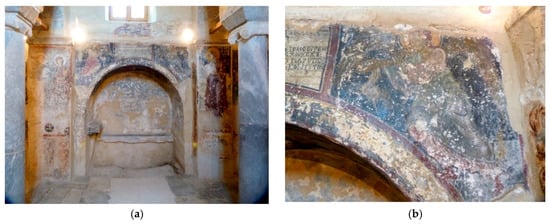
Figure 14.
Hagios Georgios in Akraifnio (Karditsa, Boeotia, Greece). (a) Arcosolium with painted inscription (1311), south of the crossing; (b) angels blowing trumpets, right spandrel of the arcosolium. © Author with the permission of the Ephorate of Antiquities of Boeotia.
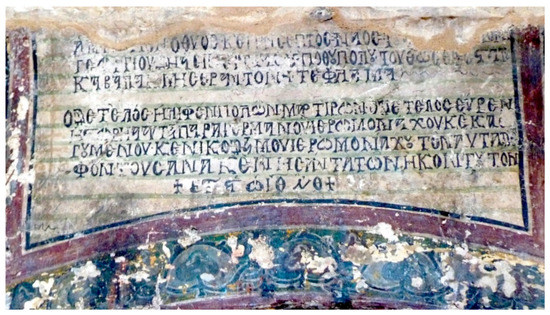
Figure 15.
Dedicatory inscription painted above the keystone of the arcosolium (1311), Hagios Georgios in Akraifnio (Karditsa, Boeotia, Greece), south wall of the crossing. © Author with the permission of the Ephorate of Antiquities of Boeotia.
However, A. Kostarelli opposes this hypothesis on the basis of the architectural phases of the building and a new reading of the text. In her opinion, the arcosolium “was clearly not intended as a burial place for Lord Antoine Le Flamenc” () and should be dated to the primary phase of the church before the time of the Frankish Lord.19 Secondly, it is very likely that the inscription was incomplete when Buchon published it in 1845 in a first attempt to read and reconstruct its content (Buchon 1845). Some decades later, in 1907, part of the plaster crackled and had to be restored as Miller explains in his 1909 publication (). Indeed, the report of the analyses carried out in 2014 shows as the inscription was then partially repainted (Oikonomou/Karydis/Kostarelli 2014) probably following the first reading made by Buchon ().
On the basis of a detailed critical analysis of the painted inscription, Alessandra Kostarelli offers a new interpretation, in which she corrects certain readings by Buchon and Miller. As can be seen below these amendments concern not only previous assumptions about Antoine le Flamenc as founder of the monument but also the hypothesis that he was buried there in recognition of the protection offered him by St George at the terrible Battle of Halmyros. Kostarelli proposes two main corrections. First, at the start of the first line—now almost lost—should be written AΝΙΣΤOΡΙΘH (“it was painted”) instead of AΝ[HΓΕΡ]ΘH (“it was raised”). Secondly, the fifth and sixth lines of the inscription, which are usually interpreted as OΔΕ ΤΕΛOC HΛΙΦΕΝ ΠOΛΩΝ ΜAΡΤΙΡΩΝ OΔΕ ΤΕΛOC ΕΥΡΕΝ (This is who received the end of many martyrs, this is the end that he found), should be rather spell OΔΕ ΤΕΛOC HΛΙΦΕΝ ΠOΛΩΝ ΜAΡΤΙΡ<I>ΩΝ ΩΔΕ ΤΕΛOC ΕΥΡΕN ἨCΤOΡHA (Such was the end of many toils. So, it came to an end this painted work…). Therefore, this would be the complete transcription of the painted text (Figure 15):
ĂΝΙCΤOΡΙΘH • OΘΥOC • ΚΕ ΠAΝCΕΠΤÒC • ΝAOC Τ[OΥ AΓΙOΥ ΜΕΓAΛOΜAΡΤΥΡOC]ΓΕΩΡΓΙOΥ • ΔHÄ CΙΝΕΡΓΙAC ℧ ΠOΘOΥ ΠOΛOΥ • ΤOΥ Θ<E>ΩCΕΒΕCΤAΤOΥΚAΒAΛAΡΙ ΜHCΕΡ AΝΤOΝH • ΤΕ ΦΛAΜA ~~~~~~OΔÈ ΤΕΛÓC•HΛΙΦÉΝ ΠOΛΩΝ ΜAΡΤΙΡ<Í>ΩΝ•OΔΕ ΤÉΛOC ΕÝΡΕΝἨCΤOΡHA AΥΤΕΙ ΠAΡA ΓΕΡΜAΝOΥ • ΙΕΡΩΜOΝAΧOΥ • ΚÈ ΚA[ΘH]ΓOΥΜÉΝOΥ • ΚΕ ΝΙΚOΔΕΙΜOΥ ΙΕΡΩΜOΝÁΧOΥ • ΤÒΝ AΥΤAΔÈλΦOΝ • ΤOΥC AΝAΚÈΝHCAΝΤA<C> ΤΩΝ HΚOΝ ΤOΥΤOΝ+ ΕΤOΥC, ČΤΏΙ͠Θ (ỈᵔΝΔΙΚΤΙΩΝOC) Θ +
Ἀνιστορήθη ὁ θεῖος καὶ πάνσεπτος ναός τοῦ ἁγίου μεγαλομάρτυροςΓεωργίου διὰ συνεργίας καὶ πόθου πολλοῦ τοῦ θεοσεβεστάτουκαβαλάρη μισὲρ Aντώνη τε Φλάμα ~~~~~~ὅδε/ὧδε τέλος εἴληφεν πολλῶν μαρτυρίων. ὅδε/ὧδε τέλος εὗρενἱστορία αὕτη παρὰ Γερμανοῦ ἱερομονάχου καὶ καθη-γουμένου καὶ Νικοδήμου ἱερομονάχου τῶν αὐταδέλ-φων τοὺς νακαινίσαντας τὸν οἶκον τοῦτονἔτους, ČΤΏΙ͠Θ ἰνδικτιῶνος Θ΄
(This godly and sacred church of the holy great martyr George was (re)painted with the assistance and great desire of the most God-respecting knight sir Antoni te Flama. Such was the end of many toils. So came to an end this painting, work by Germanus the priest-monk and monastery head and Nicodemus priest-monk, these two being brothers who renovated his church + year 6819 indiction 9th+).(source of transcription and translation: )
Once this new reading of the painted inscription is accepted, I would like to review some of the Kostarelli’s conclusions. I agree that Antoine le Flamenc simply renewed an existing church devoted to Saint George with a cycle of paintings, but I am convinced that his main purpose was to shelter his own burial. According to the inscription, the Greek monks and brothers, Germanos and Nikodemos, carried out this renewal in order to fulfil Antoine’s commission. It consists of a pictorial embellishment of the earlier church that probably also entailed a place for the knight’s burial. This was located, under an arcosolium as happened in other contemporary Byzantine (Chora in Constantinople) and Latin churches (Cathedral of Our Lady of Athens sited in the Parthenon and now in the Byzantine and Christian Museum) (; ; ). According to Kostarelli, the tomb predates Flamenc and was consequently reused for the burial of this Frankish knight ().
The setting of the painted dedicatory tabula over an Apocalyptic cycle indeed points to a funerary and memorial intention. So, on the spandrels of the arcosolium, on both sides of the inscription, there are two angels blowing trumpets to announce the beginning of the Last Judgement (Figure 14b). Moreover, in the intrados of the arch there are two stirring angels related to the opening of the Sixth Seal. On the left, one angel is rolling up the heavens like a scroll (Rev 6, 14), with the Sun and the Moon becoming black and red (Rev 6, 12) and the stars falling (Rev 6, 13) (Figure 16a). On the right, another angel is removing the mountains (Rev 16, 14) (Figure 16b). A very similar apocalyptic depiction of the angel rolling up the heavens was included, only a few years later, as a central subject in the vault of the parekklesion of Chora (Kariye Camii, Istanbul, 1315–1321), over a funerary space full of arcosolia (Figure 17).
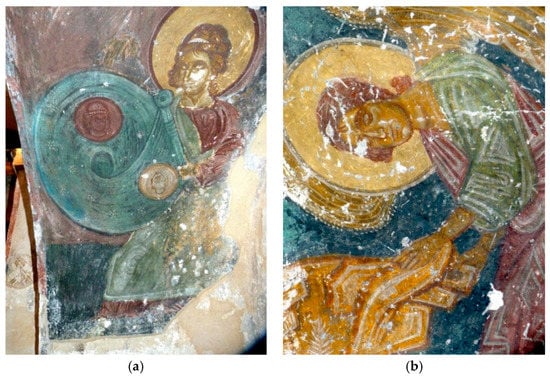
Figure 16.
Apocalyptic angels (Rev 6, 12–14) in the intrados of arcosolium (1311), Hagios Georgios in Akraifnio (Karditsa, Boeotia, Greece), south wall of the crossing. (a) Angel rolling up the heavens. (b) Angel removing the mountains. © Author with the permission of the Ephorate of Antiquities of Boeotia.
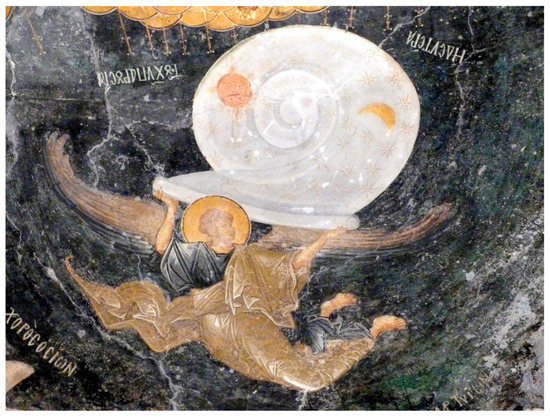
Figure 17.
Apocalyptic angel rolling up the heavens (Rev 6, 14), domical vault of the parekklesion of Chora (Kariye Camii, Istanbul) 1315–1321). © Author.
Unfortunately, the painting decorating the south wall under the arcosolium has faded. The only trace is an irregular blue layer. This colour also appears as background in the upper part of the arcosolium and in the endonarthex, both belonging to the renewal carried out by Antoine Le Flamenc. It is not possible to determine which was the subject, but it should have been related to the apocalyptic angels depicted on the inner arch. Thus, it seems likely there was a scene of the Last Judgement as in the domical vault in the parekklesion at Chora or perhaps a portrait of the donor(s) before a holy figure as in the tomb of Michael Torniakes in the same Constantinopolitan monument (Akşit 2010, pp. 178–79, 190–91). This last possibility would mean that in Akraifnio there could have been a depiction of Antoine le Flamenc together with Saint George. The formula of donor portrait together with his holy protector was had been common in this area since the 13th century, such as we can see in Porta Panagia (Thessaly, ca. 1283) () (Figure 18a), the aforementioned arcosolium at the Chora in Istanbul (14th century), or at the church of the Archangel Michael at Kavalariana (Crete) (). The omnipresence of late depictions of equestrian figures of St George in Akraifnio church, both on the north wall (16th c.?) (Figure 18b), just opposite to the tomb, and on the interior tympanum of the 19th-century addition, is worth noting. Hence, it seems reasonable to consider that the 14th century renewal of Antoine le Flamenc might have included a depiction of the saint as in many other churches devoted to the warrior from Cappadocia.
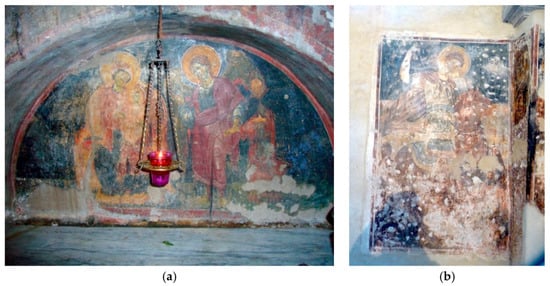
Figure 18.
(a) Funerary portrait of sebastokrator Ioannes Angelos Komnenos Doukas, arcosolium esonarthex, Church of Porta Panagia (Thessaly), ca. 1283; © Used with permission of Anastasios Papadopoulos. (b) St George slaying the dragon (16th c. (?), Hagios Georgios in Akraifnio (Karditsa, Boeotia, Greece), north wall of the crossing. © Author with the permission of the Ephorate of Antiquities of Boeotia.
Besides the painted inscription, there is some significant information collected in chronicles and records about our donor that allows us to draw up a brief biography. According to the Livre de la Conqueste, a French version of the Chronicle of Morea written between 1332 and 1346, Antoine le Flamenc was named bailiff and lieutenant in Thessaly by Guy II de la Roche, Duke of Athens (1287–1308) in 1303. The Frankish knight became Lord of Karditsa and was described in the same book as “un des plus sages hommes de Romanie” and “le plus sage dou duchame” (; ). His name and that of his son, Jean, appeared later in some Frankish and Venetian documents, even after the battle of Halmyros (15 March 1311), where the Catalans defeated the Frankish army in order to occupy the Duchy of Athens (). Indeed, the name of Ser Antonius Flamengo miles is mentioned still alive among the Greek dignitaries that have relations with Venice in a list dated to 1313 (Dynastiae Graeca; ). This means that he did not perish in 1311 in the Battle of Halmyros, in which the Franks were massacred by the Catalans.
In this regard, there two main points that should be better discussed for a better understanding of the monument and its painted inscription. First, it is likely that after the Battle of Halmyros, Antoine agreed with the Catalan Company to continue as Lord of Karditsa (). It is worth noting that the knight had a good relationship with the leaders of the Almogàvers. In a Venetian document of 1308, Antoine had been accused together with Guy II, Bernart de Rocafort—an ambitious chief of the Catalan Company (1307–1309), and Bonifacio da Verona, Lord of Karystos and the future father-in-law of Alfons Frederic, to plot to take over the entire island of Euboea (). Furthermore, in 1310 the Catalan Company had been hired by the Duke of Athens, Walter V de Brienne, to conquer some strongholds in the Despotate of Thessaly in order to protect the northern frontier of the Duchy, whose bailiff was then Antoine le Flamenc (; ). So, as a survivor of the Battle of Halmyros, Antoine was probably able to negotiate his continuation as Lord of Karditsa. It is not true that “the Catalan brothers Galceran and Francesch de Puigpardines succeeded Anthony in the lordship of Cardanica, that is, Karditsa” as Alessandra Kostarelli states (). The first mention of these members of the lineage of Puigpardines as Lords of Karditsa is very late, in 1381, within a list of ecclesiastical and laity authorities in the Catalan Greece under the kingdom of Peter the Ceremonious, in which we can read “Item Galceran de Puigpardines e Francesch germá seu, senyors de la Cadarniça e dela Talandi” (, doc. n. CDLXXXIX).
Another important point to discuss is the original location of the battle between the Franks and the Catalans in 1311. According to Ramon Muntaner’s Chronicle, chapter 240 () and Nicephoros Gregoras’ Byzantine History (VIII, vii, paragraph 5) (), the battle took place “on a beautiful plain near Thebes”, beyond the river Kephissos, wherein there was a marsh which the Catalans used as shield against the Franks () (Marcos Hierro, pp. 326–27).20 This description has led scholars such as Carl Hopf and William Miller () to identify the place with the plain of the Boeotic Kephissos and the marshes of Lake Copais (now drained), near Akraifnio. However, in 1974, David Jacoby wrote a compelling article that disputed this location. According to this scholar the fight was held in Halmyros (Almyros), in Thessaly, a town sited in the Gulf of Volos, as the earliest sources of the event report. Thus, the Greek version of the Chronicle of Morea (ca. 1320) says that Walter V of Brienne, Duke of Athens, was killed in Halmyros by the Catalan Company (“ἐκείνων που εσκοτώσασιν στον ‘Aλμυρό η Κομπάνια”) (). Likewise, the renowned Venetian statesman and writer, Marino Sanudo the Elder, who was a galley captain operating in the North Euboean Gulf on the day of the battle, both in Istoria di Romania (1326–1327) and in a letter dated to 1327 states that the fight place at Halmyros ().
In Jacoby’s view, when Muntaner mentions Thebes, he probably mistook the Phthiotic Thebes—close to Halmyros, in Thessaly—for Boeotian Thebes, which is further south (). It is worth noting that Muntaner abandoned the Catalan Company in 1307 and therefore was not an eyewitness to these events. Besides, when he wrote his Chronicle some years later, in 1325–1328, his narrative is biased and manipulative (). Gregoras, in his Byzantine History, which is still later, written in 1349–1351, furthered the misunderstanding by including a precise reference to the river Kephissos (); so that he would have been the first to identify the marshes of Lake Copais—now drained and very close to the Byzantine Akraifnio—with the place of the battle. As Jacoby pointed out in 1311 the Catalans were in Thessaly—in the area of Demetrias, Halmyros—and not in Boeotia. Besides, just some days before the battle, on 10th March 1311, the Duke of Athens had assembled his troops at Zetouni (modern Lamia), a perfect place to launch an attack on their northern opponents ().
Although Muntaner states that all the knights of the Principality of Morea died in the battle and only two escaped—Boniface of Verone and Roger Deslaur—this must be an exaggeration (). It is true that in the aforementioned list of Dinastiae Graeciae (1313) collecting the names of the lords of Romania, some of them are marked as “decessit” or “mortuus”, such as “Ser Albertus Paravicinus”, “Ser Giorgios Gisi”, or “Ser Thomas de la Sola”. Notwithstanding this, there are remarkable exceptions as “Ser Bonifacius of Verona”—who is also mentioned by Muntaner—and “Ser Antonius Flamengo miles” (). This means that Antoine le Flamenc, Lord of Karditsa, also survived the battle, and probably received the same privileges as his colleagues Boniface of Verone and Roger Deslaur. They not only kept their titles and lands but had the opportunity to increase their status. Roger Deslaur, who finally agreed to become chief of the Catalan in company (1311–1312), became the new Lord of Salona (). It was therefore dealing with a policy of agreements that allows to create a Frankish-Catalan society based on the idea of continuity.
That is why the renewal carried out by Antoine le Flamenc in the church of Akraifnio should still be seen as proof of the devotion of the Lord of Karditsa, Antoine le Flamenc, to St George as patron saint, as well as to the fulfillment of a particular vow. Although, it is true that the inscription over the arcosolium only reports the year of the work, 1311, without any further specification. In my view, the best context for the works remains after the Battle of Halmyros. It is likely that before this fight, most Frankish knights will have made their wills or expressed their last wishes in preparation for possible death. Indeed, on 10th March 1311, just five days before the combat, the Duke of Athens, Walter V de Brienne (1278–1311), assembled his forces at Lamia and made his last will and testament, which included different amounts of money to the most important Latin churches in Greece; the cathedrals of Our Lady of Athens, Our Lady of Thebes, and Our Lady of Negroponte, the great churches at Argos and Corinth, the church of Daulia, the Athenean and Theban Minorities, the Theban Frères Prêcheurs, and the church of St George at Livadia (“à Saint Jourge de la Levadie, cent parares”), as well as recording his wish to be buried in the abbey of Daphni (; ).
It is worth noting that the special gift of 100 hyperperi to the church of St George in Livadia is evidence of the apotropaic function of this saint in all Latin Greece. The Castle of Livadia, in Central Greece, had a special reputation in Latin Greece for keeping a fragment of the cranium of St George. This had probably been brought by the Franks from the Imperial Palace in Constantinople after the sack of the city in 1204. It is likely that Othon I de la Roche, first Duke of Athens (1204–1225) and Thebes (1211–1225), was the person responsible of this translation. Indeed, in 1214 he donated this castle to the Holy See and received it back from the Church, agreeing to pay for it a feudal fief of two marks a year. This was a way to restrict diocesan authority over the castle, its relics and the town, and to ensure some church revenues of the town for himself (, I, p. 214; ). Being St George the patron of knights and Crusaders, this relic of Livadia was considered a precious talisman for the Franks and later, for the Catalans, who even refused to send it to Barcelona despite repeated requests form by the Catalans kings who longed for it (; ).
Thus, the gift of Walter V de Brienne in 1311 to Livadia must be seen as a vow to the warrior saint who had protected the Duchy of Athens since the time of Othon I. It is no coincidence that the date of the renewal works in Akraifnio was this same year. The most plausible explanation is that since Antoine survived the carnage of Halmyros and renewed his position as Lord of Karditsa, he embellished the orthodox church of St George in order to fulfill a vow made before the battle. This probably happened between March 15th, the battle day, and August 31st, the last day of the year according to the Byzantine calendar. As we have seen, the project probably also entailed Antoine’s potential burial the depiction of St George as patron saint. This makes most sense of the meaning of the sentence translated by Kostarelli as “Such was the end of many toils. So, it came to an end this painting work (….)”. This is not a reference to the warrior’s death, but rather a way of expressing that the work was done quickly, in just half a year.
Once again, the choice of an Orthodox church to celebrate the memory of a Latin Lord and the fact that two Greek monks and brothers, Germanos and Nikodemos, carried out this project is a sign of the multicultural society that characterized Greece under the Latinokratia, especially in the countryside, where Latin lords did not hesitate to attend Orthodox services or hire Greek artists. All this agency took place under the protection of St George. His cross-cultural character had the capacity to tie bonds among different communities. Local Greeks, Frankish Lords, and even Catalans could share this common space under the protection of “the holy great martyr George”. Ultimately, during the battle of Halmyros both sides, Franks and Catalans, entrusted their lives to St George.
Notwithstanding perceptions of the rudeness of the Catalans who settled in Greece, it is likely that they were perfectly capable of developing a syncretic society as did their predecessors, the Franks. This seems to have been the case at Paliachora—today an abandoned city perched on a hill in the middle of the island of Aegina, in the Saronic Gulf—but which came under Catalan rule for almost a century and a half (1317–1451) (Figure 19a,b). The best buildings in Paliachora—a kind of humble Catalan Mystra—date to the 14th century when the island was under the rule of Alfons Frederic (1317–1338) and his descendants (1338–1394) (; ; ). According to the art-historical study carried out by Ermioni Karachaliou, this seminal period saw the construction of the churches of Hagios Georgios Katholikos, Hagios Dionysios, Hagios Ioannis Prodromos, Hagios Euthymios, Hagios Nikolaos of the North, and Hagios Ioannis Theologos. Most are painted with frescoes of the same period ()
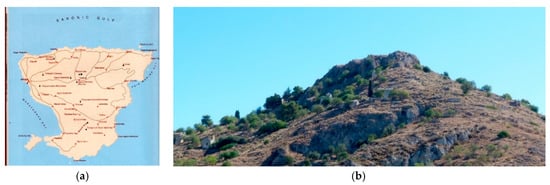
Figure 19.
(a) The island of Aegina in the Saronic Gulf. Source: (); (b) city of Paliachora on the top of a hill, island of Aegina. © Author.
As I previously published, the plan of the village is arranged in a way that seems linked to Catalan tradition. The main churches—Hagios Georgios Katholikos, Hagios Ioannis Theologos—are surrounded by squares and enclosed by low stone walls designed to protect the holy ground around the sanctuary, as had been the case of the sagreres in Catalonia since the 11th century ().21 Secondly, some of the churches—Hagios Georgios Katholikos, Hagios Ioannis Theologos—employ forms that are alien to Byzantine architecture—such as pointed vaults, heraldic crosses, and gabled bell-cotes—all of which can be found in rural parish churches belonging to the Military Orders in Catalonia, especially in the province of Tarragona (). Finally, in churches with predominantly Byzantine features (cross-in-square plan) and that were probably consecrated to the orthodox liturgy, the name of the Catalan ruler or patron is publicly displayed in a Greek votive inscription (Hagios Nikolaos Mavrikas, Hagios Ioannis Theologos) ().
One of the orthodox churches, Hagios Nikolaos Mavrikas, deserves comment given the political implications of its inscriptions and its monumental depiction of St George. This is a 12th-century cross-in-square domed church, sited on the outskirts of the city, with an eastward extension made in the 16th century () (Figure 20). The most remarkable feature of the building is the 14th-century cycle of paintings decorating the crossing, which includes two votive Greek inscriptions, both of them giving the date 1330. While that in the north arm adds the names of three lay donors—Sir Vasilissios Taratro (?), Michael, and Theodore Plakotianos—and their families, the other in the south arm mentions the priest Theodore, his wife Irene, the Catalan ruler, Alfons Frederic, and that of the painter, George of Aras ().
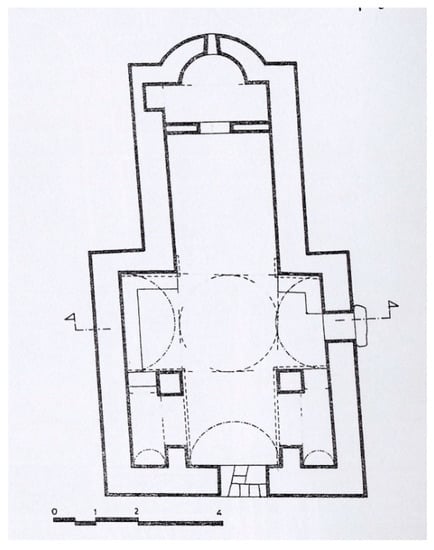
Figure 20.
Ground plan of the church of Hagios Nikolaos Mavrikas (Aegina). Source: ().
Some scholars consider the paintings to have been executed in two different phases on the basis of their stylistic features (; ). The first would date to the 13th century, with impressive depictions of the Pantokrator and St George on horseback with spear and dragon, respectively sited on the north and east wall of the north arm of the crossing (Figure 21a,b). The second may correspond to the year 1330, as provided by the inscriptions, and encompass scenes of the Raising of Lazarus, the Birth of the Virgin, the Pentecostest, Saint Basil, and the Virgin Chalkoprateia, all of them depicted on the west wall of the crossing. However, it is more likely that the whole of the pictorial programme was carried out in one go by two different painters in 1330, during the Catalan period ().
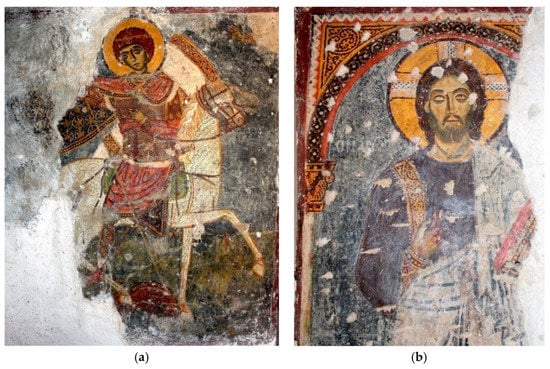
Figure 21.
Mural paintings in the crossing of Hagios Nikolaos Mavrikas (Aegina), ca. 1330 (a) St George, east wall. (b) Pantokrator, north wall. © Author with the permission of the Ephorate of Antiquities of Western Attica, Piraeus, and Islands.
Given its exceptional importance for my research, I will first focus on the inscription that publicly displayed the name of the Catalan ruler in the south arm of the crossing (Figure 22 and Figure 23):
HCΤOΡΙΘH H ΠAΡOΥCA ΚAΜAΡA ΔHA ΕΞOΔOΥ ΘΕOΔΩΡOΥIEPEOC TOY ΠOΤ(Ε) ΠAΠA ΤOΥ CAΚΤOΥΡAΡΙ KE MNHCTHTI K(YPI)E THN ΨΥΧHΝ THC ΔOΥΛH(C) COYHPHNHC TH(C) CHNBIOY AYTOY EN THHMEPA THC KPICEΩC AMHN (ETOYC) ϚΩΛH: ηστορίθη δε δηά χηρ(ός) κ[αμού γεω]ργίου του αρά αμήν:Aφεντέβοντος δε ντον αλφ---οςηός ρέ φεδερήγουTHIS ARCH (chamber or vaulted space?) WAS PAINTED AT THE EXPENSE OF THEODOROS/THE PRIEST {SON?} OF THE FORMER PRIEST THE ACTUARIUS AND REME/MBER LORD THE SOUL OF YOUR SERVANT/EIRENE HIS WIFE IN THE/JUDGEMENT DAY AMEN (YEAR) 6/838: painted by the hand of myself George of Aras amen:/during the reign of don Alfonso/son of king Federick22
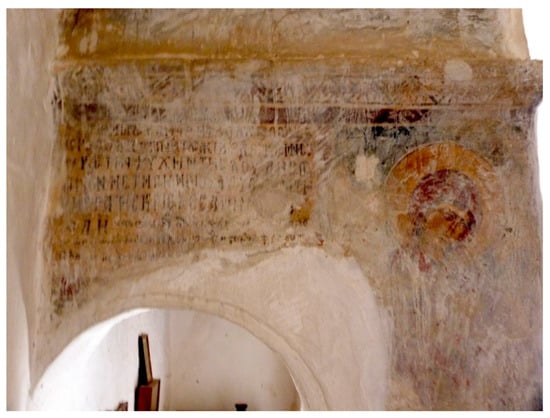
Figure 22.
Dedicatory inscription (1330), Hagios Nikolaos Mavrikas (Aegina), south arm of the crossing, west wall. © Author with the permission of the Ephorate of Antiquities of Western Attica, Piraeus, and Islands.
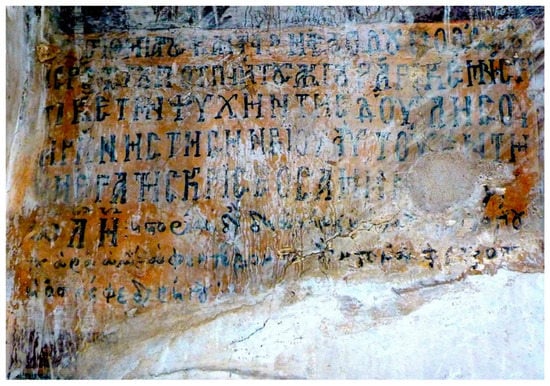
Figure 23.
Dedicatory inscription (1330), Hagios Nikolaos Mavrikas (Aegina), south arm of the crossing, west wall. © Author with the permission of the Ephorate of Antiquities of Western Attica, Piraeus, and Islands.
Firstly, it is notable that both inscriptions in the church are written in capital letters. This is common in monumental inscriptions and icons. The use of capital letters derives from Antique uncial writing and conveyed prestige and authority. However, the reason for the display of capital letters in these humble churches is also based on the fact that in Byzantium elementary education used capital letters (). Even a middle-trained man (spoudaios)—as many of the middle-class Greek society (administrators, priests)—learnt to read and write in capital letters. This meant that most villagers would have been semi-literate because they were not able to read in lower-case letters.
Hence, the significance of the addition of a final section in lower-case in the inscription. This only refers to the signature of the painter and to mention to the Catalan ruler. This means that the painter was capable of writing in lower-case letters, so that he was probably literate though as his spelling in the first part of the inscriptions is poor, it is likely that he was in the category of a spoudaios. Only genuine scholars—perittoi—had the capacity to write and read in perfect lower-case letters (). It could be concluded that the painter added this final formula in lower-case as proof of modesty as well as to record in writing that the island was “under the rule of the Catalans”.
The formula used to state that the paintings were undertaken “during the rule of Don Alfonso, son of king Frederick—αφεντέβοντος δε ντόν αλφ (…)ος/ηός ρέ φεδερήγου)—seems to be taken from a diploma. Don Alfons Frederic d’Aragó (Alfonso Fadrique in Spanish) (1290/94–1338), was a natural son of king Frederick II of Sicily, who became chief (presidens) of the Catalan Company (Societas Magna Romaniae) and Vicar General of the Duchy of Athens between 1317 and 1330. He was brought up in Barcelona, at the court of his uncle, King James II of Aragon, and in 1317 married Marulla, daughter of the aforementioned Boniface of Verona, Lord of Karystos and Aegina. After Boniface’s death in 1317/1318 Alfons became one of the most powerful men in Latin Greece by accumulating his wife’s dowry (Karystos and Aegina). This consolidated his position as military leader in the Duchy of Athens (1317), while some conquests in southern Thessaly—Neopatras, Zetounion, Loidoriki, Siderokastron, Vitrinitsa, Domokos, and Farsala—allowed him to incorporate the Duchy of Neopatras to the Catalan domain. From 1319 he was Vicar General of the Duchies of Athens and Neopatras and 1320 became Lord of Salona (Amphissa), the most important lordship in Catalan Greece. Finally, in 1330, Alfons was granted the title Count of Malta and Gozzo, though he remained in Greece until his death (; ).
This reference to a Latin Lord and his royal lineage is quite exceptional in an Orthodox church, especially in Aegina, where some decades earlier (1289) in Omorphi Ekklesia, the Greek inscription only mentioned the emperor Andronikos II Palaiologos and the Patriarch of Constantinople, Athanasios I, and ignored the Frankish rulers of the island ()
As such, the inscription reflects a change in the self-perception of the Orthodox community in Aegina, which was probably looking to obtain protection from its new Latin and powerful Lord. Behind this shift of identity from Rhomaios to Catalan lies a recognition of the foreign authority. The year 1330 marked the onset of Turkish raids to capture slaves in the Aegean islands, which according to Marino Sanudo the Elder was especially aggressive in the years 1331–1332, when 25,000 Greeks were seized to be sold (). This period was a turning point in relations between the Catalans and the Venetians, as in 1331 both parties signed an agreement in which “the Catalans should conclude no new alliances with the Turks and should not aid them in attacks upon the island of Negroponte or any of the lesser islands of the Archipelago” (; ). However, it must be recalled that the Catalans also participated in this market for Greek slaves in their own raids in Epiros and Korinthos (). This particular context of fear would be the most auspicious time for the local population in Aegina to seek protection from the almighty don Alfons Frederic. The crowd-funding system, which is attested by both inscriptions probably involved the most important people in the village—Sir Vassilios Taratros (?), Michael and Theodore Plakotianos, and the priest Theodore—who were eager to be protected by their new Latin Lords. Furthermore, the church elected for this collective agency was devoted to St Nicholas, patron of sailors and shipping, an activity that was fundamental during the Catalan period given the island’s situation in the middle of the Saronic Gulf (). This example of cultural fusion and mutual acceptance between the two ethnicities has a contemporary precedent in the Cretan church of Saint Michael in Kavalariana (Kandanos, Selinou) (1327–1328) (Figure 24), in which the Greek donors are depicted wearing Latin-like clothes—with heraldic motives—and accompanied by an inscription that states that the island was then ruled by “the great Venetians, our Lords” ().23
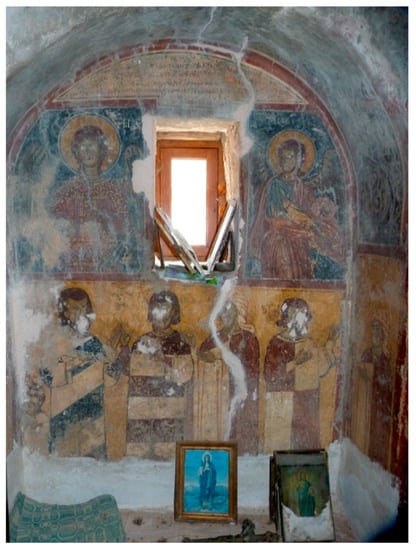
Figure 24.
Lay donor under the protection of the Archangels Michael and Raphael, 1327–1328, church of the Archangel St Michael in Kavalariana (Kandanos, Selinou) (Crete), north wall. © Author.
It is not by chance that the most conspicuous subject depicted in Hagios Nikolaos Mavritas is that of St George killing the Dragon. As stated above, this depiction along with that of the Panktokrator were dated to the 13th century on the basis of some stylistic similarities to the paintings of St. Peter at Kalyvia-Kouvara (Attica) (1232/33), such as the rendering of the eyes and the contours of the face.24 However, as far as the image of St George is concerned, the pictorial features and motifs are more akin to that of the Frankish gate house in the citadel of Nauplia. They have the same voluminous curly hair crowned by a diadem and he wears an oblong shield hanging over his back. The date that Monika Hirschbilder proposed for Nauplio, between 1291 and 1311 (), acts perfectly well as a terminus post quem for Hagios Nikolas Mavritas, and better fits the date of the painted inscriptions in Aegina (1330). Indeed, the dark shading along the profile of face and eyes and the aristocratic poise of St George in Aegina are generally characteristic of the Palaiologan art.
Furthermore, the ornamental arcade framing the Pantokrator includes a Gothic crocket capital with a crenellated abacus and collar that betrays knowledge of a Latin repertoire. Its features are slightly finer than the crocket capitals produced in 13th-century Morea, like those found in the ruins of the Cistercians abbeys of Zakara and Isova (Figure 25a,b).25 It might therefore be deduced that this Palaiologan painter—a colleague of George of Aras—had access to foreign models perhaps related to a courtly entourage. The white horse of St George stands out from other contemporary depictions by being beautifully decorated by circles. This motif is unusual in Byzantine iconography and seems to be a reception of the spotted pale horses that were common in the depiction of warrior saints in Sicily and Apulia, as in the chapel of St John the Baptist at the Castle of Paternò dated to the 13th century () or in the crypt of St. Nicholas at Faggiano (Taranto) (around 1300) (Bari, Pinacoteca Provinciale, inv. 1993, n. 58–60) () (Figure 26a,b). The context of Catalan rulership in Athens and Sicily could foster this migration of motifs from Southern Italy to Greece, especially during the period of Alfons Frederic (1317–1330), natural son of King Frederick II of Sicily (). He arrived in 1317 in the Duchy of Athens as an effective representative of the king together with a number of Catalan, Aragonese, and Sicilian noblemen who stablished in these lands ().
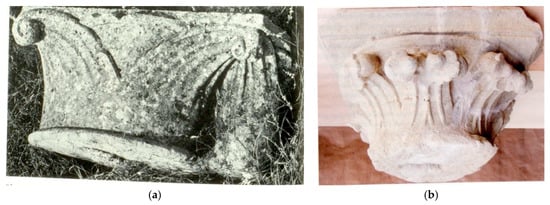
Figure 25.
Cistercian crocket capitals in the 13th-century Morea. (a) Zaraka Abbey. Source: (); (b) Our Lady of Isova. Source: ().
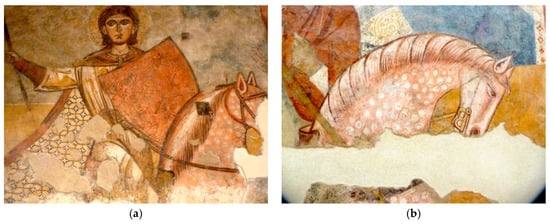
Figure 26.
Warriors saints in Southern Italy. (a) Chapel of St John the Baptist at the Castle of Paternò (Sicily), 13th c. © Used with permission of Ángel Bartolomé. (b) Detail of the horse of St Theodore, crypt of St Nicholas at Faggiano (Taranto), around 1300. Bari, Pinacoteca Provinciale. © Author with the permission of the Pinacoteca Provinciale di Bari Corrado Giaquinto.
Although the cult and image of St George was one of the most popular in both Frankish and Palaiologan painting in Greece, the saint always conveyed a special significance for the Catalans.26 In their first military confrontations against the Greeks in Gallipoli—the Battle of Branchialion—and Apros (1305) the Catalan army invoked the patronage of St George in a rehabilitated idea of crusade. Thus, according to Ramon Muntaner’s Chronicle (chapters 219–221), the Catalan warriors went into the battle flying a banner that depicted St George and using war cry “Sant Jordi!, Aragó!” (Saint George! Aragon!) or “Via sus, via sus! Sant Jordi, sant Jordi!” (Up to them! Up to them! Saint George, Saint George!) (; ; ).
Just one year earlier, during the campaign against the Turks in Asia Minor, Ramon Muntaner recounts a symbolic episode, which happened in Thyatira and shows the special devotion of the Catalan Company to St George (Chronicle chapter 206). This narrative should be seen as an anticipatio of the future protection afforded by the Cappadocian saint over them. The nobleman En Corberan d’Alet and 10 other Christians were killed by the Turks in the outskirts of the city of Thyatira (Akhisar) (Asia Minor). Then, Roger de Flor, Captain of the Company and Grand Duke (μέγας δούξ) of the Byzantine Empire, had fine tombs made for them in the church of St George in Thyatira, in which, according to Ramon Muntaner “rests the body of monsenyer Saint George” and “it is one of the most beautiful churches that I have never seen” (Chronicle, chapter 206: ; ; ). It is obvious that this account compares the deaths of the Catalans in combat to the feats of the Cappadocian megalomartyr and pays a special tribute to their memory by burying them in a sacred place near the relics of St George. However, the overstated tone used by the author leads us to suspect that this episode was partially invented by him to enhance the memory of his companions. This otherwise marvelous building devoted to St George is not mentioned by any other author ().
Once the Catalan Company began to act as an independent and sovereign entity, it created a seal consisting of an image of the saint on a horse. According to Muntaner’s Chronicle (Chapter 225,) the first version of this stamp was issued in Gallipoli in 1305 and was accompanied by the legend: “Segell de la host dels francs qui regnen lo regne de Macedonia” (Seal of the Host of the Franks who are ruling the kingdom of Macedonia (; ). Notwithstanding this, David Jacoby has shown that the first edition of the seal was 1307 when the Catalans entered the Kingdom of Macedonia (). Later, in 1312, once they were installed in the Duchy of Athens and they recognized the authority of king Frederick II of Sicily (of the House of Aragon), they started to use a double seal in their chancellery and substituted for the word Macedonia that of Romania, a term that refers to the lands belonging to the Byzantine Empire before the Fourth Crusade (). Fortunately, an impress of this seal in wax survives in the collection of the Count Pierre of Viry and consists of the imprint of two different stamps (Figure 27). While the front bears the seal of the Company with an image of St George on a horse slaughtering the Dragon and accompanied by the legend—“SIGILLUM FELICIS EXERCITUS FRANCORUM IN ROMANIE PARTI COMMORATIS”, the reverse shows that of the coat of arms of Aragon-Sicily which is encircle by the text: “SIGILLUM FELICIS EXERCITUS FRANCORUM” ().27
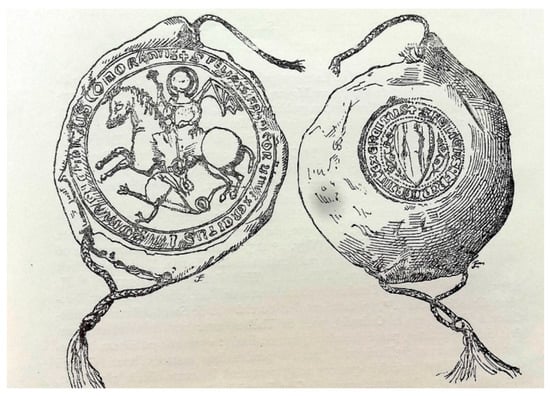
Figure 27.
Imprint of the double seal of the Grand Catalan Company, 1312–1214. Source: ().
The double seal confirms condominium over these newly conquered lands. In 1312, when the Company recognized the authority of Frederick II of Aragon, king of Sicily, Frederick named his son Manfred, Duke of Athens, and sent his representative, Berenguer Estanyol, to be Vicar of the Duchy. Meanwhile, the crown ensured the individual and collective rights that the Company and its members had acquired in Greece (; ). A second example of this double seal was in two documents issued on 26 May 1314 in Thebes by the chancellor of the company, Jacobum de Sarriano, in which Guy Dauphin, baron de Montauban, received the Kingdom of Thessalonki and the Castle of St Omer in Thebes. A copy of these acts is kept in a manuscript belonging to the Library of Dom Bernard de Montfaucon, O.S.B. (1655–1741) (Paris, BN lat. 5456, fols. 27r-29v) that also includes a drawing with the double stamp (f. 29v) (Figure 28) (; ; Rubio 2001, docs. n. LXX-LXXI, pp. 88–89).
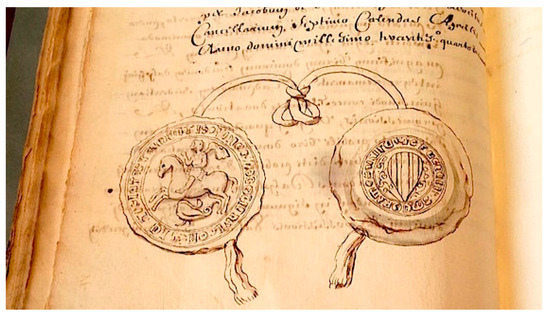
Figure 28.
Double seal of the Grand Catalan Company, 1314. Paris, BN lat. 5456, fol. 29v. © Used with permission of Bibliothèque Nationale, Paris.
As we have seen, from the beginning the Catalan Company seems to have been protected by the shield of St George. The cult and their devotion to it should be seen as further evidence of the fascination that the Catalans and the Latins, as heirs of the Crusaders, felt for the Cappadocian hero when they established themselves in Greece. The depiction at Hagios Nikolaos Mavritas, in the outskirts of Paliachora, is a seminal work for a better understanding of the cross-cultural value of the image of St George, patron of the Catalan Company and his Lord, Alfons Frederic. As George is also a popular Byzantine saint in whom the local population sought protection in those troubling times the saint acted as a mirror reflecting their identity and was therefore a symbol of the bond between the two ethnicities, Catalan and Greek.
The apotropaic function of images of St George in Catalan Greece is beyond doubt. As we have seen, the Castle of Livadia, in Central Greece (Figure 29), housed a fragment of the cranium of St George. This had probably been brought by the Franks from Constantinople after the sack of the city in 1204. The relic was considered such a precious talisman for the Company that they refused to send it to Barcelona despite repeated requests sent in 1354 and 1355 by the Catalan king, Peter the Ceremonious (1319–1387), and even in 1381 when he became Duke of Athens and Neopatras (; ; ).28 Later, once the Navarrese Company took Livadia, his son and heir, John I of Aragón (1387–1396) tried again to incorporate it in his famous collection of relics in Barcelona and wrote on 13 April, 1393 three desperate petitions without success.29 Finally, knowing that the relic had moved to the island of Aegina, King Martin the Humane of Aragon (1396–1410) wrote three letters in 1399, 1402, and 1409 in order to persuade the new lord of the island, Aliot de Caupena, to deliver the precious head of St George (). Aliot had been close to his son, Martin the Younger, king of Sicily (1292–1409), and Martin the Humane reminded him in his petition in 1399 that he had flown the banner of St George in Sicily and knew that this saint was “cap, patró intercessor de la casada d’Aragón” (head, patron and intercessor of the House of Aragon) (, doc. n. DCLV, pp. 682–83).30
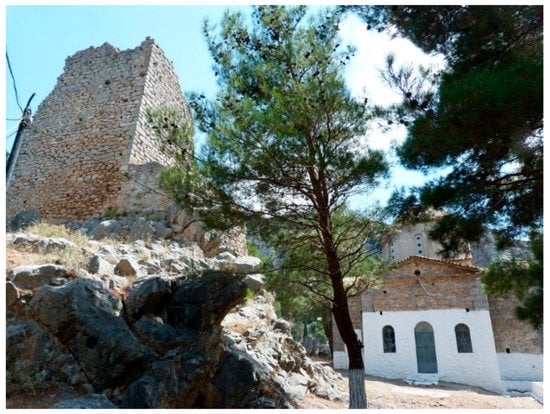
Figure 29.
Castle of Livadia (Boeotia), the keep and the churches of Hagia Sophia and Hagia Barbara. © Author.
There is no doubt that there was a conflict of interests between the Catalan Company and the kings of Aragon. For each, the possession of the relics of St George had a different meaning. The Company and its heirs, the Lords of Aegina, looked on the relic as a talisman that protected these brave and daring warriors in a foreign land as the Cappadocian hero had done with the Crusaders in the Battle of Antioch. On the contrary, the Aragonese kings were eager to get hold of it as symbol of their House and join it with other relics to emphasize the sacred character of the dynasty and the wide power the Aragonese enjoyed in the Mediterranean.
Once the Catalans were expelled from Livadia, at the end of the 14th century, they took this precious treasure with them to Aegina, their last stronghold in Greece, and put in the church of Hagios Georgios Katholikos () (Figure 30a,b). Although the arrival of the relic in Aegina is a bit confusing, it is likely that Aliot de Caupena was responsible. In 1393, the relic was in the possession of the Gascon knight, Bertranet de Salahia (or Mota), Lord of Livadia, who wanted to contact the king of England in order to sell it (, docs. n. DCXXXVII-DCXXXVIII, pp. 606–67). However, between that date and 1399, the relic was acquired by Aliot de Caupena, former Cup-bearer to King Martin the Younger of Sicily (1292–1409) (). Aliot had come to Greece before 1397 in order to marry a high rank woman, probably the daughter of Joan Frederic d’Aragó (+1394), and thus became new Lord of Aegina ().31 The purchase of the relic by his part indicates once again how important was for the Catalans to recover this talisman and keep it in their last refuge in Greece.
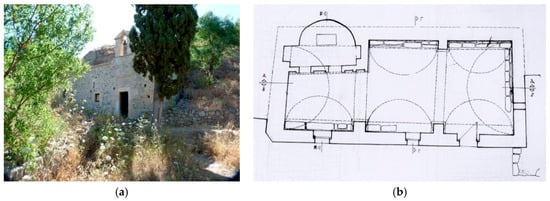
Figure 30.
Church of Hagios Georgios Katholikos, Paliachora (Aegina), end of the 14th c. (a) View from the west © Author; (b) ground plan. Source: ().
The hybrid character of the architecture of Hagios Georgios Katholikos and some features of its ground plan suggest a late 14th-century date. According to Moutsopoulos and Karachaliou the church belongs to a distinctive Byzantine type of martyrion, which is characterized by a basilica with a traverse sanctuary. Being in this case an aisleless church (just 11 m × 4 m), the sanctuary in placed in the north part of the church but keeping its eastern orientation (Figure 30b). This specific location allowed to celebrate the liturgy there while the pilgrims could pay their respects to the relic in the nave (N-S) and exit without interrupting the liturgy by the entrance in the western wall (; ). Thus, the church was organized hierarchically, one space for the liturgy, another for the pilgrims.
Such architecture might have been built at the end of the 14th-century when the Catalans acquired the cranium of S. George and brought it to this church. Our evidence is as follows. First, the church is in the main square of the town, in a sort of courtyard that is marked out by a low wall as is usual in the Catalan sagreres.32 This space could host the major feast and allow the faithful to follow services from outside (). Thus, it seems to be an architectural and urban plan created with the arrival to the precious relic.
Second, the architecture is a hybrid drawing on both Byzantine and Latin traditions. The nave is covered by a pointed barrel vault that is supported by transverse arches on corbels (Figure 31). These corbels are set on the spandrels of a series of arcosolia that form the side walls and mounted on stone benches. This was old-fashioned at the end of the 14th-century and recalls castle chapels or constructions carried out by the Military Orders in the 12th- and 13th-century Catalonia, such as Sant Miquel de Monclar, San Julià d’Alfara de Carles, and Saint Joan d’Algars () (Figure 32a,b).
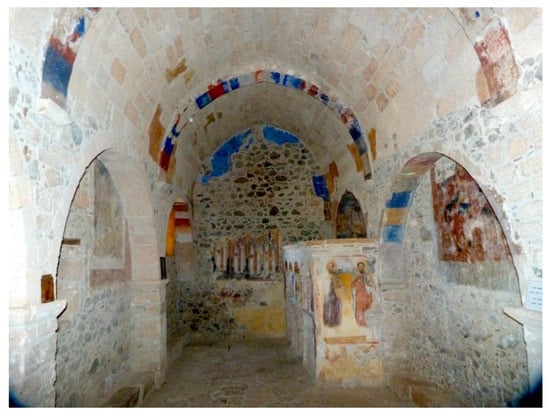
Figure 31.
Interior of the Church of Hagios Georgios Katholikos, Paliachora (Aegina), end of the 14th c. © Author with the permission of the Ephorate of Antiquities of Western Attica, Piraeus, and Islands.
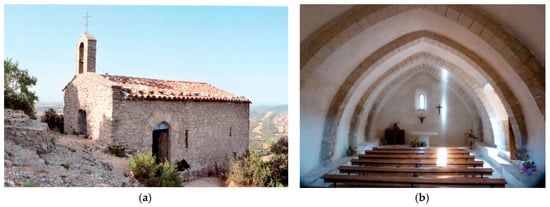
Figure 32.
Castles chapels in the province of Tarragona (Catalonia, Spain). (a) Church of Sant Miquel de Montclar (Order of the Templars). (b) Church of Sant Julià d’Alfara de Carles. © Author
This combination of archaizing Latin schemes with elements of Byzantine architecture, like the iconostasis in the sanctuary, is specific to the art of the sort of cross-cultural society that characterized the Latin States in the Levant. As Maria Georgopoulou pointed out with regard to the 12th- and 13th-century architecture of the Crusaders and Eastern Christians, their buildings tend to be very conservative, and include distinctive details in order to identify to which religious community they belong. However, they always manage to hold enough in common to exhibit a collective identity; that of belonging to the Latin domain (; ; ). Although we do not know how this system of construction was conveyed from the western Mediterranean to the east, it is very likely that the masons working in Paliachora had learnt it from the shipyards in the Saronic Gulf, where the Catalan fleet had one of its bases.33 Indeed, the keel of a galley might be a perfect pattern from which to build a pointed barrel vault reinforced by transverse arches on corbels () as happened in Acre or in Chania ().
Thirdly, an engraved inscription in the nave dated to between 1715 and 1821 reports a reconsecration of the church in order to affirm it as Orthodox: “Καθ[η]γιάσθη μ’άγιασμόν/ό θειος Ναός της Παναγίας της Μεσοσποριτίσσας/Τον ξαναπήραμε άπό τούς Φράγκους/οί Χριστανοί” (It was sanctified with Holy Water/the sacred church of the (Panagia) Mesosporitissa/We took it back from the Franks/the Christians) (; ). Most scholars interpreted this to indicate a return to the original dedication, Panagia Mesosporitissa, but the text actually says that the church was given back to the Orthodox. As we have seen, both its architectural type and artistic features point to construction in the 1390s when the relic of St George arrived on the island. Thus, it is likely that Hagios Georgios Katholikos was its original name, the adjective “katholikos” being an indication of the Latin Catholic dedication of the church. After the second Venetian rule of the island (1687–1715), the church was finally reconsecrated for the Orthodox community.
This does not mean, however, that during the Catalan period the relic was not the subject of a shared cult between Latins and Greeks, and consequently a symbol of the bond between the two ethnicities.34 It is likely that the holy remains had performed the same function in the castle of Livadia (), where cohabitation between Greeks and Catalans is well documented. There, the Greek family de Mauro Nicolao were given Catalan citizenship (1311), and enjoyed the privilege whereby they could marry Latin women while keeping to Orthodox religion (1366). Some of its members, such as Constantine, notary of the city, held public offices and obtained the right of perpetual usufruct for his family (see n. 14). Majors’ feasts, such as that of St George, might have been a public occasion in which liturgies and processions were shared in order to strength the bond between the two communities. Mixed families would have played an outstanding role in these. It is worth noting that the grant of the extraordinary right of mixed marriage to the family de Mauro Nicolao in Livadia contained the formula “sub sigillo beati Georgii” (, doc. n. CCLXVIII, p. 353), “under the seal of St. George”, which meant that the Cappadocian hero was acting once more as guarantor of the authority of the Catalans over Greece and protector of this new syncretic society.
The presence of that relic in Aegina was well known in the first half of the 15th century. The Italian traveller, Christophoro Buondelmonti, described it in his Liber Insularum Archipelagi (1420), X, 79: “Et ad Eginam hanc insulam, ubi caput sancti georgii adoratur, in conspectu urbi Athenis, venimus” (And we arrived in this island of Aegina, before the city of Athens, where the head of St George is venerated” () This text was profusely illustrated in the 15th century and some editions include a depiction of the fortified structure of Paliochora with the legend “Opidum in quo caput sancti Giorgii” (Stronghold where the head of St George is) (Paris, BN Ms. latin 4824, f. 52r (1465–1475) (Figure 33).35 However, the most extraordinary episode with the relic happened during the reign of Alphonsus the Magnanimous, king of Aragon, Sicily, and Naples (1416–1458), who sent the pirate Bernat I de Vilamarí to Aegina in order to bring him the holy relic. After threatening the citizens, he was able to obtain it in exchanging of money. Nevertheless, once he set out to sea with his precious treasure a violent storm ensued and the crew prayed for salvation to the head of St George. However, the relic had miraculously vanished and gone back in Aegina! (). The Venetians, who took the island in 1451, would be the only one able to bring it in the West in 1462 where, up until now, it has been deposited in the beautiful church of San Giorgio Maggiore ().
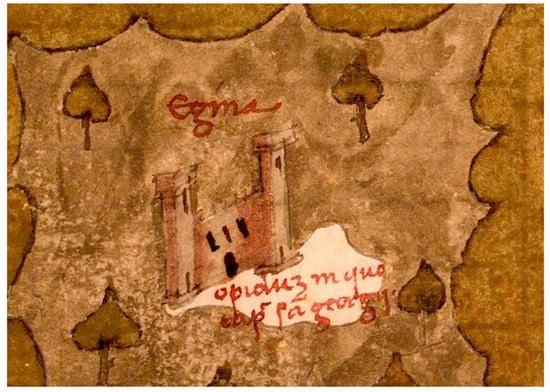
Figure 33.
City of Paliachora with the cranium of St George. Christophoro Buondelmonti, Liber Insularum Archipelagi, X, 79. Paris, BN Ms. latin 4824, f. 52r (1465–1475). © Used with permission of Bibliothèque Nationale, Paris.
Nonetheless, Aegina and Livadia were not the only places in Greece to witness public tribute to St George on the part of the Aragonese. In the second half of the 14th century, a new Latin force assumed a leading role in the fight against the Turks both in continental Greece and the Aegean: The Order of St John. In this struggle to maintain the Latin presence in the East, the Cappadocian saint once more became the subject of artistic commissions. These were related to two outstanding Aragonese knights: Juan Fernández de Heredia), Grand Master of the Order of Saint John (1377–1396), and Íñigo de Alfaro, lieutenant of the draper at the Hospitaller headquarters in Rhodes and, later, castellan of Smyrna during the siege of the city of 1402.36 In Rhodes, their coat of arms, along with that of Pierre de Culant, were carved on the marble plate above the main entrance of the chapel of St George in the fortifications, just in the south-eastern bastion of the Collachium (; ). This votive chapel was built during the stay of Heredia in Rhodes between 1379 and 1382, or maybe a little bit later, when Pierre de Culant became lieutenant of the Grand Master, between 1382 and 1396.37 Its dedication is justified by the known role of St George as protector of the knights but it should be also seen as evidence of the renewed crusading ideal that the Order of St John of Jerusalem embraced in their struggle against the Muslims throughout the 14th century. Exploits such as the capture of Smyrna (1344), the sack of Alexandria (1366), or the unsuccessful battle of Nicopolis (1396) (Lutrell 1960, p. 253) were probably occasions to entrust the souls of Christian warriors to the mythical liberator of Antioch and Jerusalem.
More intriguing and puzzling is the second monument related to the Spanish Hospitallers in Greece. This is the church of St George in the castrum of Geraki. According to Aspasia Louvi-Kizis, the Order of St John renewed this building around 1378–1381, adding a narthex and a south aisle to a double-aisled structure, which dated to the Frankish period (around 1204–1270) (). Proof of this Hospitaller commission are the Crosses of the Order decorating the entrance to the narthex as well as both sides of the structure standing against the north wall and framing a depiction of St George in the north aisle (Figure 34a,b).
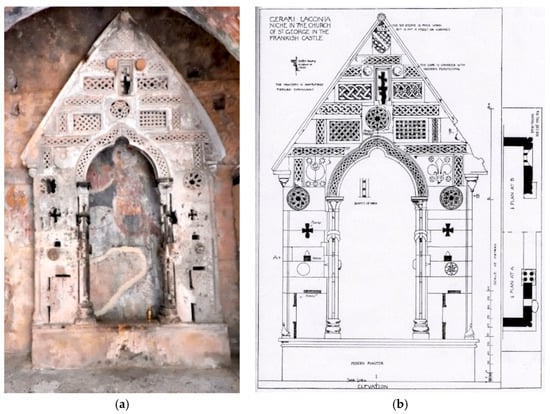
Figure 34.
Stone gabled aedicule (proskynetarion or tomb?) with a depiction of St George, chapel of Hagios Georgios in the castrum of Geraki, north aisle, 1378–1381 (?). (a) General view © Used with permission of the Ephorate of Antiquities of Lakonia, Hellenic Ministry of Culture and Sports/Archaeological Resources Fund; (b) drawing. Source: ().
In the past, this bizarre furnishing—a type of gabled aedicule—was interpreted as a 13th-century proskynetarion (προσκυνητάριον) related to the Nivelet family—that is to say an oratory with a mural icon of the patron saint of the church for the worship.38 An analysis of the three carving shields on the gable, however, led Aspasia Louvi to propose a later date and a different function for the structure. She identified the coat of arms embellishing the aedicule—“ecu echiqueté avec une bande”—as belonging to the family of Iñigo Alfaro on the basis of the likeness to one of the shields in the chapel of St George in the fortification at Rhodes (Figure 36a). The author argues that the monument might originally have been a tomb for a sibling of Iñigo Alfaro, who would have accompanied him in the campaign that Heredia set up in Morea between 1377 and 1381 ().
Fortunately, two 14th-century depictions of St George provide a chronological marker and an explanation for this bizarre gable-shaped aedicule. On the one hand, this monument was erected on the north wall of the church, where there was an earlier mural painting depicting the equestrian figure of St George slaughtering the dragon. This early depiction is accompanied by a votive inscription referring to the Σεβαστός Τζαούσιος Ισα(α)κιος, who was probably the commander of the garrison of the kastron.39 The tzaousios was a well-documented rank in the Despotate of Morea between 1297 and 1374/75, combining military and administrative roles (; ) It is worth noting the choice of Isaakios, who, as the commander in office, did not hesitate to dedicate a votive depiction of the patron of the church, St George, emphasizing once more his special protection over the Byzantine military class. According to Aspasia Louvi, this depiction was painted shortly before the renewal of the church undertaken by the Knights Hospitaller ().
On the other hand, a second depiction of St George—a genuine standing Byzantine warrior, crowned by a luxury diadem and raising his sword—is located on the north pier of the central nave framing the 13th-century templon (Figure 35). The painting has been dated to the period of the tomb (1378–1381), as the saint is bearing a round shield, which is decorated with the coat of arms of the Alfaro couple with a Crescent Moon and Star. This mixing of Latin and Byzantine heraldry in depictions of St George is very common in the art of Morea and usually conveys the exchange, emulation, or association of identities (). In this case, it is not only a proof of the ‘national’ devotion of Aragonese knights to St George but also, as we will see below, a kind of mark of the Hospitaller alliance with the Byzantine Despotate of Morea at that time.
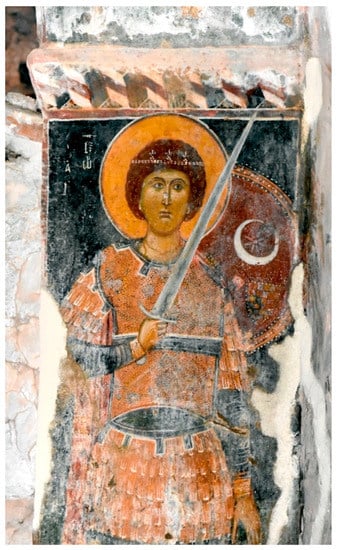
Figure 35.
Mural depictions of St George standing and wearing the shield with the coat of arms of the family Alfafro, chapel of Hagios Georgios in the castrum of Geraki, central nave, NE pier, west side, 1378–1381. © Used with permission of the Ephorate of Antiquities of Lakonia, Hellenic Ministry of Culture and Sports/Archaeological Resources Fund.
It is worth remembering that shortly after his appointment as Grand Master of the Order, in 1377, Heredia launched a crusade in Romania to stop the advance of the Turkish troops in mainland Greece. For that purpose, he obtained from Jeanne de Naples the Principality of Achaea for five years, and landed with his knights in Greece. His dreams of Crusade soon failed, however, and he was captured in 1378 in Arta (Epiros) following which the Order was obliged to pay a high ransom for his release in 1379 (; ; ). According to Aspasia Louvi, the Latin princess, Isabelle de Lusignan, widow of Manuel I Kantakouzenos, Despot of Morea (1354–1380) was involved in this, and she loaned a large amount of money—9500 ducats—to the Order of St John of Jerusalem. Indeed, with regards to the last part of this debt, Isabelle herself moved to the Hospitaller Headquarters in Rhodes in Spring of 1382 (), which underlines her familiarity with the heads of the Order.
Although we are not told the reason for this huge credit, it is likely that the money served to pay the rescue of Heredia in 1379 and the Morea campaign (1377–1381). Aspasia Louvi hypothesized that Iñigo Alfaro had taken part in these actions and wanted to be buried in Geraki, a village belonging to the Byzantine Despotate of Morea, an alleged brother who presumably died during the fights against the Turks (). As is well known, Isabelle together with her husband “promoted a policy to maintain friendly relations with the Latins in Greece” (), kept in touch with her relatives in Cyprus and even built in Mystras a monastery following the Latin rite; the Peribleptos (). To this extent, it is possible that during the Morea campaign, the Hospitallers renewed the chapel of St George in the castle of Geraki and raised a “monument” to a deceased warrior created by a Latin workshop from the Peribleptos. Indeed, besides the coat of arms of Alfaro family, two emblems related to the ruling Despots of Morea were carved on the spandrels (Figure 34b): The fleur-de-lys, which Isabelle had used in Peribleptos along with the lion of the Lusignan as a sign of her French lineage (, pp. 108–9, figs. 11, 13). The crescent with the stars was also used in the aedicule, as a symbol of the Byzantine Emperor () and, as we have seen, the Knights Hospitaller did not hesitate during the renewal of the church to commission a painting of St George wearing this Greek heraldry along with the blazon of the Alfaro.
Thus, the three shields on the gable make up an iconographic programme intended to underline the military alliance between Latins and Byzantines under the auspices of Isabelle de Lusignan and the Hospitallers, all of it under the protection of the Cappadocian saint. Indeed, in the centre of the gable there is an incised double cross that probably represents the Patriarchal Cross of Jerusalem, one of the emblems of the Hospitallers, and which appears in in some bulls issued by Juan Fernández de Heredia (, p. 240, n. 208) (Figure 36a,b). Ultimately, by accepting that the monument sheltered the tomb of a sibling of Alfaro and the dates and patronage suggested by Aspasia Louvi, the most convincing explanation for such an aedicule might be its dual function as burial and memorial. The two depictions of St George—one already extant and incorporated into the monument, the other specifically made for the renewal—not only celebrate his role as protector of the Crusading knights—with a specific national reminiscence for the Alfaro and Heredia entourage—but also the covenant between Latins and Greeks. In this it promoted a cult that could be shared by the local population living in fear of the advance of the Turks. This shows more than ever the intercultural aspect of the cult of St George—by his celebration in the church in a kind of shared shrine—as well as the transcultural movement of a genuine Byzantine iconography into a Latin environment. All of this was made possible by the commitment of a transcultural and transnational institution: The Order of St John of Jerusalem.
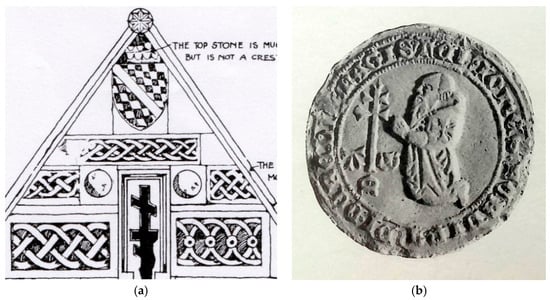
Figure 36.
(a) Upper part of the stone gabled aedicule with the shield of Alfaro and the Patriarchal Cross of Jerusalem, chapel of Hagios Georgios in the castrum of Geraki, north aisle, drawing. Source: () l; (b) Juan Fernández de Heredia kneeling and praying before the Patriarchal Cross of Jerusalem, seal of a bull of the Order of St John of Jerusalem issued in Rhodes during the rule of Juan Fernández de Heredia (1377–1396). Source: ().
2.4. Epilogue. The Mythification of Saint George in the Kingdom of Aragon
Deus, qui beato Georgio, martiri tuo, suis meritis victoriam in bellis tribuisti, concede propicius ut quam eius bene sciencia postimus victoriam de inimicis nostris eius auxilio consequamur, per Dominum. (Letter of King Peter the Ceremonious to the bishops of the Kingdom, on 5 November 1356, Arxiu de la Corona d’Aragó (ACA), Can. Reg. 1.380, ff. 70v-71r).()
At this point, one begins to wonder whether the myth of St George in Greece fuelled the adoption of the saint as protector of the House of Barcelona in the Kingdom of Aragon in the 14th century.40 Indeed, before the exploits of the Grand Catalan Company in Greece (1303–1311) the Cappadocian saint does not seem have had a significant institutional role in the history of the lands conforming the Crown of Aragon: Aragon, Catalonia, and Valencia. His progressive affirmation seems to have been the result of a cause-and-effect process that runs in both directions. Sometimes the kingdom mirrored in its lands the deeds of the saint—or deeds done in the name of the saint—in the East. At other times, as we have seen in Anatolia and Greece, the kingdom was able to pursue a quest for the sacred that involved the Cappadocian saint. This provoked a phenomenon that Natasha Eaton clearly defined for the art of colonialism as “mimesis in flux”, in which art becomes a network of artworks and each link in the chain must be seen as a result of a continuous transfer ().
This ongoing process probably began when King Peter the Catholic founded the Order of St George of Alfama in 1201 to conquer lands from Islam in the southern expansion of the kingdom of Aragon (, II, xxvii, p. 434; ; ; ). It is obvious that this first impulse was related to the military character of George and the fame of his intervention in the Battle of Antioch (1098) in favor of the Crusaders.41 However, it is also highly likely that in the context of the Iberian Reconquista and the fight against the Almohade threat the creation of such an order was an Aragonese response to the establishment of the Order of St James in the Kingdom of León in 1171. Ultimately, both saints, James and George, were imagined by their respective armies as holy riders on white horses helping them during the battle against the Muslims ().42
In any case, this revival of the Crusading spirit explains the inclusion of the first reference to St George in the description of the conquest of Majorca in 1229 by King James the Conqueror of Aragon (1215–1276). This account, written many decades later, around 1270, relates that according to the Moors the first knight to enter the city was a “white horseman bearing white arms”, which Christians interpreted as a miraculous apparition of St George as he used to do in other battles against the Muslims (The Llibre des feits, 84, ; ; ; ). Indeed, this passage is again a clear mention to the Battle of Antioch, where an equestrian George, “whiter than the snow that falls at the end of February”, leads to the battle camp a company of white warriors made up of Mauricius, Demetrios, and Mercurios (). As in the case of the aforementioned Battle of Prinitza (1263) in the Pelopponese, such a marvellous apparition in Majorca lends an aura of prestige and sanctity to the Latin warriors and compares them to their precursors, the admired crusaders. As a result, a series of guilds of St George were scattered throughout the newly conquered lands and especially supported by the kings James I (Teruel 1263), James II (Murcia 1303), and Peter the Ceremonious (Valencia 1353) (; ; ).
This same Crusading spirit also explains the inclusion of the cross of Sant Jordi (St George) among the heads of four Muslims in a seal of Peter III of Aragon dated to 1281. Some scholars interpret this insignia as a direct reference to the alleged apparition of St George in the Battle of Alcoraz) that enabled the Christian army to conquest Huesca in 1096 (). Nevertheless, as we will see, the first mention of this episode in the chronicles of the Kingdom of Aragon is later, mid-14th century, in the time of King Peter the Ceremonious ().
Indeed, the true instigator of the cult of St George in the Crown of Aragon was Peter the Ceremonious (1336–1387) within a programme which promoted the sacralization of the monarchy. This entailed an obsessive quest for St George (; ; ; ). Only then do the Catalan chronicles start to multiply miraculous interventions by George in the more important battles of its history such as Alcoraz (1096) or El Puig (Valencia) (1237). I would like to stress that this happened after the exploits of the Grand Catalan Company in Anatolia and Greece, in which St George had enjoyed and continued to enjoy a prominent place. Thus, the anonymous author of the Chronicle of San Juan de la Peña (1369–1372) cheats us by placing the Battle of Alcoraz (1096) at the same date than that of Antioch (1098) and includes an apparition of St George picking up a German Crusader knight on his horseback in order to transfer him from the siege of Antioch to the Battle of Alcoraz (, chap. 38, p. 40). Likewise, following one of the most famous episodes of the Chanson d’Antioch (, 358, p. 313), the Cappadocian saint accompanied by his militia breaks into the Battle of El Puig (Valencia) to help the Christians against the Muslims (, chap. 35, pp. 92–93).
As a result, the imagery of the Kingdom of Aragon is shaped by the shadow of Crusader exploits in the East. St George became the holy protector of the king and the Catalan armies in the Iberian Peninsula as well as in Greece. As result his memory glowed and, as we will see, he became the subject of public celebration that spurred the collective identity of the communities that settled in the newly conquered lands. Proof of his new status under the rule of King Peter the Ceremonious (1336–1386) was the construction of two Gothic-mudejar chapels in the renewed royal palace in the Aljaferia at Zaragoza: One devoted to St Martin, the other to almighty St George () (Figure 37).
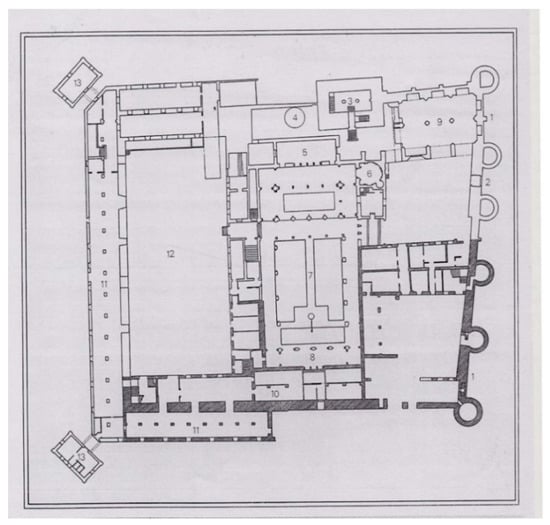
Figure 37.
Ground plan of the Aljafería (Zaragoza, Spain), with the chapels of St Martin (9) and St George (10). Source: ().
Up until the 12th century St Martin was the patron of chivalry in Catalonia and Aragon, and his devotion was especially cultivated by the Counts of Barcelona (). With the union of the two dynasties—Barcelona and Aragon—in 1137, this cult continued in the Crown of Aragon. This begins to change in the 13th and 14th centuries, however, as the cult of Martin was progressively substituted by that of St George, which stepwise diffused across the kingdom. Thus, in Valencia, before the year 1343, the feast of St George—diada de Sant Jordi—was already publicly celebrated (). Moreover, in 1365 Peter the Ceremonious founded there the urban militia Centenar del Gloriós Sant Jordi or Centenar de la Ploma—a company of 100 crossbowmen whose commitment was to guard the banner of Valencia, that is the banner of the king. It is no coincidence that the most compelling mythification of the bonds that tied George to the Aragonese King and his army was the great altarpiece known as “del Centenar de Ploma”, which was paid for by the confraternity of these crossbowmen to be installed in the high altar at the church of the Order of St George d’Alfama in that city (, II, ix, p. 305). This extraordinary artwork, now in the Victorian and Albert Museum (London), was mostly painted between 1400–1405 by Miquel Alcañiç and Marçal de Sas (; ).43 Its central panel shows King James I fighting together with St George to defeat the Muslim king of Valencia at the Battle of El Puig. On the one hand, the King, distinguished by the royal crown and the bat-shaped crest, and his horse are wearing the colours of the royal banner, which was also the banner of the city () (Figure 38a). On the other hand, George and his horse are decorated with the Cross of St George, which was distinctive of the militia of the crossbowmen (Figure 38b). Such imagery might have been seen by the members of the confraternity as a symbolic mirror of their militia and mission as guardians of the royal banner and protectors of the city. Thus, St George is wearing three elegant and slim feathers (ploma) that characterized the garments of “The Hundred of the Feather”. Every year, during the feast of the Christian conquest of the city (9 October), this altarpiece and, especially, its central panel came to life as an object of public celebration, since the church of St George was one of the stations of the citizen procession ().
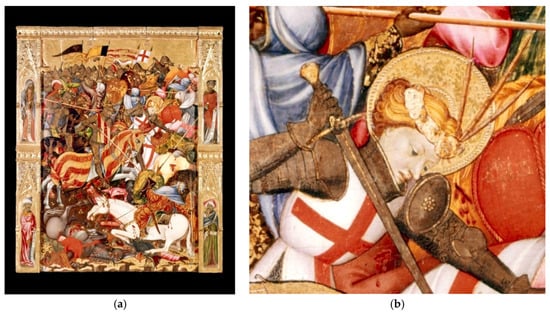
Figure 38.
Miquel Alcañiç and Marçal de Sas, Altarpice “del Centenar de Ploma”, Valencia, 1400–1405, Victoria and Albert Museum © Used with permission of the Victoria and Albert Museum, London. (a) Central panel: Jaume I fighting together with St George to defeat the Muslim king of Valencia at the Battle of El Puig; (b) detail of St George decorated with the Cross of St George and wearing three elegant and slim feathers (ploma) that characterized the garments of “The Hundred of the Feather”.
Likewise, in Majorca at least since 1348, the Feast of the Conquest or Feast of the Standard took place, in which an honorable citizen on horseback waved the vexillum regum at the gates of the city while a sermon was recited following some rites based on those of the church of the Holy Sepulchre in Jerusalem (). As happened in Valencia, this celebration became a public tribute to the miraculous intervention of St George in the conquest of the town. Thus, in the altarpiece executed by Pere Niçard and Rafel Moger around the middle of the 15th century for the guild of St George in the city, one of the predella scenes depicts the entry of the Catalan army into Majorca with a glittering St George at its head, followed by King James I (, II, pp. 56, 89, 1978, III, p. 147; ; ) (Figure 39).
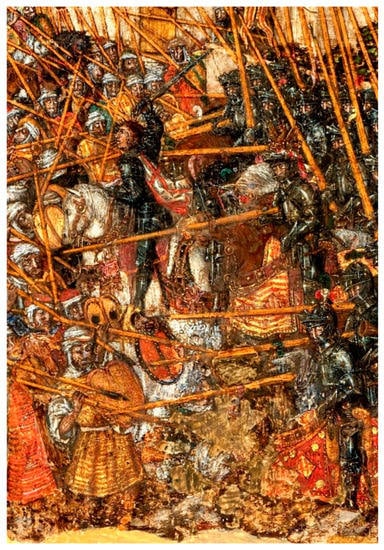
Figure 39.
St George and King James I conquering the city of Majorca, Pere Niçard, and Rafel Moger, Altarpiece of St George, predella, Majorca, 1450–1468. Museu Diocesà de Mallorca Museu d’Art Sacre de Mallorca. © Used with permission of Museu d’Art Sacre de Mallorca—Capítol Catedral de Mallorca.
Nevertheless, it must be recognized that the emergence of the cult of St George during the time of Peter the Ceremonious is a complicated matter with many causes. Beyond the myth of the Crusade and the fascination for the exploits of Catalan warriors in Greece, there were other political reasons within the Iberian and European context that are relevant. At the very beginning of the Castilian-Aragonese war (1356–1375), in 1356, Peter the Ceremonious ordered all the bishops of the kingdom to pray to St George to obtain his favor and blessing. This special prayer was a war cry with Crusading echoes. It included a formula based on Mathew 16, 24–18 that invited the faithful “to take up the cross” (). This empowerment of George should be also seen as an Aragonese response to the holy warrior par excellence in Medieval Spain, St James, patron of their rivals of Castile-Leon.
On the other hand, Peter the Ceremonious could have been interested in the sacralization of English kingship and the creation of the Order of the Garter carried out by Edward III in 1348 in the context of the 100 Years’ War (Collins 2000; ; Bianchi 2011, pp. 74, 86; ). The invocation to the glorious St George in the battle and the wonderful collection of his relics in the chapel of Windsor probably spurred a similar policy on the part of Pere the Ceremonious.44 As we have seen in 1354 this King initiated a campaign to obtain the cranium of St George in Livadia (Greece) that his sons, John I and Martin the Humane, continued even when this relic was transferred into the island of Aegina.45 Moreover, Peter renewed the old Order of Saint Jordi d’Alfama with new statutes that were approved by Pope Gregory XI in 1373. A solemn chivalric ordination ceremony then took place in the chapel of St Agatha at the royal palace in Barcelona, wherein the King gave with his own hands the white robes decorated with the red cross of St George to the new master, Guillem Castell (, II, xxviii, pp. 436–38; ; ). Later, as the new Duke of Athens and Neopatras, he did not hesitate to transfer this institution into Greece. Thus, in 1381 the most important authorities in Greece were made knights of St George and from Zaragoza they were sent white cloaks with the red cross to wear each Saturday and on the feast of St George (, docs. n. CDXCIV and CDXCVI, pp. 551–52). Later, in 1382, Heinrich, bishop of Salona, asked the King to establish the Order of St George in the legendary castle of Livadia, where the precious cranium was kept (, doc. n. DXII, p. 563; ).
The two-directional journey of the myth of St George ended up with a painting that reflects the particular appropriation of the saint by the House of Aragon-Barcelona. I am referring to the intriguing triptych with the Virgin with the Child, St George, and St Martin, dating to the end of the 14th century and now in the Isabella Stewart Gardner Museum in Boston (Figure 40). The panel has been attributed to Francesc Comes the Younger, a painter of the International Gothic, who is documented in Mallorca from 1392 to 1415 (; , III, pp. 72–73).
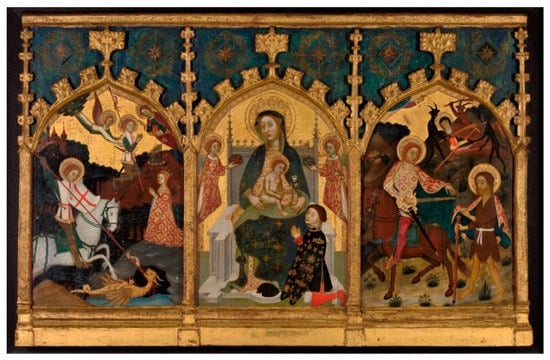
Figure 40.
Francesc Comes the Younger (?), Triptych with Virgin and Child with St George and St Martin, ca. 1395. © Used with permission of the Isabella Stewart Gardner Museum, Boston.
It is likely that the painting was a commission from a male member of the royal house of Aragon, depicted kneeling in prayer next the Virgin. This is based on fairly solid evidence. First, the side panels are devoted to two saints important to the House of Aragon—St George killing the dragon and St Martin cutting his cloak. As we have seen, these were the dedication of the chapels in the 14th-century palace of La Aljaferia. Second, the male donor is dressed in a black robe which is lavishly decorated with golden emblems and letters. Among them stands out the double crown (Figure 41a,b). This is a distinctive device of the dynasty ruling Aragon and Sicily, created during the reign of Joan I (1387–1196) and which his brother and heir, Martin the Human, also wore from 1392 as regent of the island (; ; ). Indeed, the latter is depicted wearing the same emblem in a panel of the Last Judgement attributed to Gherardo Startina and dated around 1400 (Munich, Alte Pinakothek) ().
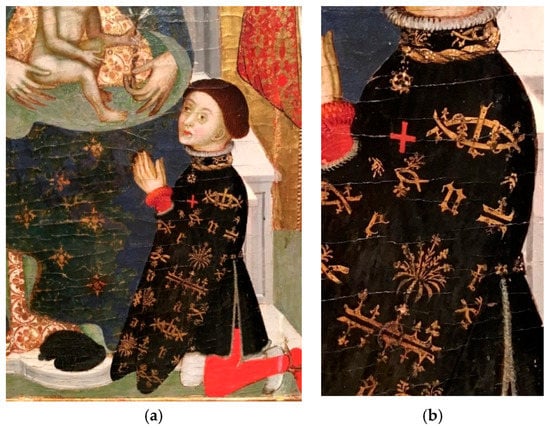
Figure 41.
Kneeling donor identified as Martin the Humane as regent of Sicily, Francesc Comes the Younger (?), Triptych with Virgin and Child with St George and St Martin, ca. 1395. © Used with permission of the Isabella Stewart Gardner Museum, Boston. (a) Detail of the kneeling donor. (b) Detail of the robes of the kneeling donor with the Cross of St George and the double crown.
Finally, an ornamental motif decorating the upper background of the panel consists of six eight-pointed stars in rhomboids also seems to be an emblem used by the House of Barcelona/Aragon (Figure 42a). Indeed, the depiction of this star accompanying royal portraits was common in the royal seals from the time of James I and has been interpreted as a reference to Mary as Stella Maris (; ) (Figure 42b). Its depiction on the panel is unsurprising since the Virgin with the Child is the central subject of the painting.
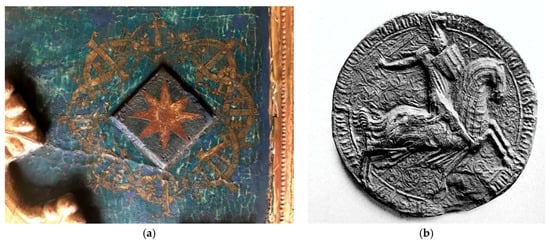
Figure 42.
(a) Eight-pointed star, Francesc Comes the Younger (?), Triptych with Virgin and Child with St George and St Martin, ca. 1395, upper part. © Used with permission of the Isabella Stewart Gardner Museum, Boston; (b) seal of Peter the Ceremonious with the star. Source: ().
On the basis of a doubtful reading of the golden letters decorating the garments of the donor, this was identified by Van de Put as Frederick of Aragon and Sicily (1402–1428), a bastard of Martin the Younger, king of Sicily (1401–1409) (). This is impossible as he was only born after the panel was painted. In my view, some elements suggest that the donor depicted was the future King Martin the Humane (1356–1410), seen shortly before he acceded to the throne (1396), while he was still Duke of Montblanc and regent of Sicily. As is well known, this prince was possessed of a chivalric spirit and love of luxurious jewels, intaglios, and devices (; ). This might explain the lavish necklace and the double crown—as regent of Sicily, the undecipherable impress on his robe and even the red cross of St George as patron of his dynasty. Moreover, the dual devotion to Martin and George is undoubtedly a reference to the traditional devotions of the House of Aragon and, particularly, to the prince’s name.
The panel might have been commissioned between 1392 and 1395 when Martin, as regent of Sicily, tried to recover the Duchy of Athens and Neopatras and purchase the relic of St George in Livadia. In 1393 his brother, King John I, wrote to him and his vassal Ramon de Montcada asking them to convince the new Lord of Livadia, Bertranet de Salahia, to sell this precious treasure and not give it to Richard II of England (1377–1399), who was also very interested in it (, docs. n. DCXXXVIII-DCXXXIX, pp. 667–68). As a result of all this, the making of the Boston triptych under the auspices of Martin would epitomize the secular fight for St George that had nourished so many episodes in Latin Greece and ended up as a symbol of the competition between kingdoms in Western Europe.
Funding
This research was mostly funded by the Ministry of Science, Innovation and Universities of the Government of Spain (MICINN-HAR2015-63883-P) within a project entitled: Movilidad y transferencia artística en el Mediterráneo medieval, 1187–1388: artistas, objetos y modelos.-MAGISTRI MEDITERRANEI (see www.magistrimediterranei.org). To complete this study I also enjoyed a stay as Samuel H. Kress Senior Fellow at the Center for Advanced Study in the Visual Arts (CASVA) in the National Gallery of Washington, during the year 2017–2018, with the project: “Shifting Identities and Traveling Objects: Artistic Encounters with Byzantium during the Expansion of the Crown of Aragon”.
Acknowledgments
I would like to express my gratitude to Sophia Kalopisi-Verti, Nancy Sevcenko, Olga Vassi, Anastasia Drandaki, Aspasia Louvi-Kizi, Stella Chrisoulaki, Alexandra Kostarelli, Mark Evans, Nathaniel Silver, Catalina Mas, Juan Signes, Prita Meier, Silvia Tita, Verónica Abenza, Iker Spozio, Carles Sánchez, Ángel Bartolomé, and, especially, to Anastasios Papadopoulos and John McNeill, for the facilities afforded to me in the preparation of this contribution.
Conflicts of Interest
The author declares no conflict of interest.
References
Primary Sources
Avril, François, and Marie-Thérèse Gousset. 1984. Manuscrits Enluminés D’origine Italianne. 2. XIIIè Siècle. Paris: Bibliothèque National de France.Morel-Fatio, Alfred, ed. 1885. Libro de los Fechos et Conquistas del Principado de Morea Compilado por Comandamiento de don Fray Johan Ferrández de Heredia. Geneva: Imprimerie Jules-Guillaume Fick/Société de l’Orient Latin.Bibliography
- Albera, Dionigi, and Benoît Fliche. 2012. Muslim Devotion Practices in Christian Schrines: The Case of Istanbul. In Sharing Sacred Spaces in the Mediterranean. Christians, Muslims and Jews at Shrines and Sanctuaries. Edited by Maria Couroucli and Dionigi Albera. Bloomington: Indiana University Press, pp. 94–117. [Google Scholar]
- Anglès, Higini. 1961. L’ordre de Sant Jordi durant els segles XIII-XV i la devoció dels reis d’Aragó al Sant Cavaller. In Miscel·lania dedicada a E. Fonserè i Riba. Barcelona: Gustavo Gili, pp. 41–65. [Google Scholar]
- Anguera, Pere. 2004. Sant Jordi, patró de Catalunya. Estudis d’Història Agrària 17: 67–76. [Google Scholar]
- Anuari. 1921–1926. El Segell de la Companyia Catalana d’Orient. Anuari de l’Institut d’Estudis Catalans VII: 302–4. [Google Scholar]
- Athanasoulis, Demetrios. 2013. The Triangle of Power. Building Projects in the Metropolitan Area of the Crusader Principality of the Morea. In Viewing the Morea. Land and Peole in the Late Medieval Peloponnese. Edited by Sharon E. J. Gerstel. Washington, DC: Dumbarton Oaks, pp. 111–51. [Google Scholar]
- Ayensa i Prat, Eusebi. 2013. Els Catalans a Grècia. Castells i Torres a la Terra dels Déus. Barcelona: Editorial Base. [Google Scholar]
- Babuin, Al. 2011. Annexe: Les Illustrations du Petropolitanus Graecus 115. In Greeks, Latins and Intellectual History 1204–1500. Edited by Martin Hinterberger and Chris Schabel. Leuven, Paris and Walpole: Peeters, pp. 235–42. [Google Scholar]
- Barsanti, Claudia. 2001. Costantinopoli e l’Egeo nei primi decenni del XV secolo: La testimonianza di Cristoforo Buondelmonti. Rivista dell’Istituto Nazionale d’Archeologia e Storia dell’Arte 56: 83–254. [Google Scholar]
- Bartusis, Mark C. 1989. The Megala Allagia and the Tzaousios: Aspects of Provincial Military Organization in Late Byzantium. Revue des études byzantines 47: 183–207. [Google Scholar] [CrossRef]
- Baydal Sala, Vicent. 2010. Santa Tecla, San Jorge y Santa Bárbara: Los monarcas de la Corona de Aragón a la búsqueda de reliquias en Oriente (siglos XIV–XV). Anaquel de Estudios Árabes 21: 153–62. [Google Scholar]
- Bogevska, Saska. 2012. The Holy Trinity in the diocese of the archbishopric of Ohrid in the second half of the 13th century. Patrimonium 10: 139–73. [Google Scholar]
- Bon, Antoni. 1969. La Morée Franque. Recherches Historiques, Topographiques et Archéologiques sur le Principauté d’Achaïe (1205–1430). Texte. Paris: Éd. De Boccard. [Google Scholar]
- Bowman, Glenn. 2012. Identification and Identify Formations around Shared Shrines in West Bank Palestine. In Sharing Sacred Spaces in the Mediterranean. Christians, Muslims and Jews at Shrines and Sanctuaries. Edited by Maria Couroucli and Dionigi Albera. Bloomington: Indiana University Press, pp. 10–28. [Google Scholar]
- Brooks, Ernst Walter, ed. 2006. Acts of Saint George (Analecta Gorgiana 8). Piscataway: Gorgias Press LLC. [Google Scholar]
- Budge, Ernst Alfred Wallis. 1930. George of Lydda, the Patron Saint of England: A Study of the Culture of St. George in Ethiopia. London: Luzac’s Semitic Text and Translation Series, p. 20. [Google Scholar]
- Buondelmonti, Chistophoro. 1824. Liber Insularum Archipelagi. Edited by G. R. Ludwig von Sinner. Lepizig and Berlin: G. Reimer. [Google Scholar]
- Cacho Blecua, Juan Manuel. 1997. El Gran Maestre Juan Fernández de Heredia. Zaragoza: Caja de Ahorros de la Inmaculada de Aragón. [Google Scholar]
- Carreras Candi, Francesch. 1916. Introducció de la festa de Sant Jordi en la Corona d’Aragó. Butlletí Centre Excursionista de Catalunya XXVII 256: 113–22. [Google Scholar]
- Castiñeiras, Manuel. 2016. Paliachora (Egina), el Sinaí y Cataluña a finales del siglo XIV: Hibridación artística, política y peregrinación en el Mediterráneo oriental. In Imagens e Liturgia na Idade Media. Edited by Carla Varela Fernandes. Lisboa: Bens Culturais da Igreja, vol. 5, pp. 9–56. [Google Scholar]
- Castiñeiras, Manuel. 2018a. Weaving Stories, Images and Devotions: The Medieval Mediterranean as a Stage. In Ein Meer und seine Heiligen. Hagiographie in mittelalterliche Mediterraneum. Edited by Nikolas Jaspert, Christian A. Neumann and Marco di Branco. Paderborn: Ferdinand Schöningh, pp. 69–107. [Google Scholar]
- Castiñeiras, Manuel. 2018b. Shifting Identities and Traveling Objects: Artistic Encounters with Byzantium during the Expansion of the Crown of Aragon. In Center 38. National Gallery of Art. Center for Advanced Study in the Visual Art. Record of Activities and Research Reports, June 2017–May 2018. Washington, DC: National Gallery of Art, pp. 85–87. New York: Harry N. Abrams, pp. XXIII–XXXVIII. [Google Scholar]
- Castiñeiras, Manuel. 2018c. Patrons, institutions and public in the making of Catalan Romanesque art during the Comital period (1000–1137). In Romanesque Patrons and Processes. Design and Instrumentality in the Art and Architecture of Romanesque Europe. Edited by Jordi Camps, Manuel Castiñeiras, John McNeill and Richard Plant. New York: British Archeological Association/Routledge, pp. 143–58. [Google Scholar]
- Castiñeiras, Manuel, and Abenza Verónica. 2014. Sant Martí de Puigbò: Una iconografia per a Ramon Berenguer III? In Pintar fa mil anys. Els colors i l’ofici del pintor romànic. Edited by Manuel Castiñeiras and Judit Verdaguer. Bellaterra: Servei de la Universitat Autònoma de Barcelona, pp. 71–86. [Google Scholar]
- Cavallo, Guglielmo. 2017. Leer en Bizancio. Buenos Aires: Colección Scripta Manevit. [Google Scholar]
- Chapman, Conrad. 1926. Michel Paléologue, Restaurateur de L’empire Byzantine (1261–1282). Paris: Éugene Figuière. [Google Scholar]
- Cingolani, Stefano. 2014. Sant Jordi, una llegenda mil·lenària. Barcelona: Editorial Base. [Google Scholar]
- Cingolani, Stefano M. 2015. Vida, viatges i relates de Ramon de Muntaner. Barcelona: Editorial Base. [Google Scholar]
- Cooper, J. Eric, and Michael J. Decker. 2012. Live and Society in Byzantine Cappadocia. New York: Palgrave Macmillan. [Google Scholar]
- Couroucli, Maria. 2012a. Sharing Sacred Places. A Mediterranean Tradition. In Sharing Sacred Spaces in the Mediterranean. Christians, Muslims and Jews at Shrines and Sanctuaries. Edited by Maria Couroucli and Dionigi Albera. Bloomington: Indiana University Press, pp. 1–9. [Google Scholar]
- Couroucli, Maria. 2012b. Saint George the Anatolian: Master of Frontiers. In Sharing Sacred Spaces in the Mediterranean. Christians, Muslims and Jews at Shrines and Sanctuaries. Edited by Couroucli Maria and Dionigi Albera. Bloomington: Indiana University Press, pp. 118–40. [Google Scholar]
- D’Alòs-Moner, Ramon. 1926. Sant Jordi, patró de Catalunya. Barcelona: Barcino. [Google Scholar]
- De la Figuera, Gaspar (Frey). 1738. Vida, Martirio, Reliquias, Templos, Milagros, Apariciones i Excelencias del Insigne Mártir i Esforzado Capitán de Christo San Jorge. Valencia: Imprenta de Antonio Balle. [Google Scholar]
- De LaRoncière, Charles. 1929. Les Portulans Italiens. Lyon: Amis de la Bibliothèque de Lyon. [Google Scholar]
- De Sagarra y Siscar, Fernando. 1898. Apuntes para un estudio de los sellos del rey D. Pedro IV de Aragón: Memoria leída en la Real Academia de Buenas Letras de Barcelona en sesión de 25 de Enero de 1892. Memorias de la RealAcademia de Buenas Letras de Barcelona VI: 101–74. [Google Scholar]
- Delahaye, Hippolite. 1966. Les Passions des Martyrs et les Genres Littéraires. Bruxelles: Société des Bollandistes. [Google Scholar]
- Delaville le Roulx, Joseph. 1913. Les Hospitailers à Rhodes Jusqu’à la Mort de Philibert de Naillac. Paris: Ernest Leroux Editeur. [Google Scholar]
- Delehaye, Hyppolite, ed. 1902. Synaxarium Ecclesiae Constantinopolitanae: E Codice Sirmondiano nunc Berolinensi; Adiectis Synaxariis Selectis. Bruxelles: Socios Bollandianos. [Google Scholar]
- Delehaye, Hyppolite. 1909. Les Légendes Grecques des Saintes Militaires. Paris: Picard. [Google Scholar]
- Dorsch, Klaus J. 1983. Georgszyklen des Mittelalters. Frankfurt am Main: Peter Lang. [Google Scholar]
- Duran i Duelt, Daniel. 2018. Los ducados de Atenas y Neopatria en el comercio regional e interanacional durante la dominación catalana (siglo XIV). I. El comercio regional a través del observatorio de Candía. Estudios Bizantinos 6: 111–46. [Google Scholar]
- Eaton, Natasha. 2013. Mimesis across Empires. Artworks and Networks in India. Durham and London: Duke University Press, pp. 1765–860. [Google Scholar]
- Edgington, Susan, and Carol Sweetenham, eds. 2011. The Chanson d’Antioche: An Old-French Account of the First Crusade. Farmham: Ashgate. [Google Scholar]
- Egea, José M., ed. 1996. La Crónica de Morea. Madrid: CSIC. [Google Scholar]
- Eliades, Ioannis A. 2017. The Painting Production of the 13th Century in Cyrprus between Two Worlds. In Maniera Cypria. The Cypriot Painting of the 13th Century between Two Worlds. Edited by Ioannis A. Eliades. Byzantine Museum of the Archbishop Makarios III Foundation: Lefkosia, pp. 45–63. [Google Scholar]
- Expósito Sebastián, Manuel, José Luis Pano Gracia, and Mª Isabel Sepúlveda Sauras. 1996. La Aljafería de Zaragoza. Guía histórico-artística y Literaria. Zaragoza: Cortes de Aragón. [Google Scholar]
- Fancy, Husein. 2016. The Mercenary Mediterranean. Sovereignty, Religion and Violence in the Medieval Crown of Aragon. Chicago and London: The University of Chicago Press. [Google Scholar]
- Fort i Cogul, Eufemià. 1971. Sant Jordi d’Alfama. L’Orde Militar Català. Barcelona: Rafael Dalmau. [Google Scholar]
- Geanakoplos, Deno John. 1953. Greco-Latin Relations on the Eve of the Byzantine Restauration: The Battle of Pelagonia—1259. Dumbarton Oaks Papers VII: 101–41. [Google Scholar]
- Geanakoplos, Deno John. 1959. Emperor Michael Paleologous and the West, 1958–1282. A Study in Byzantine-Latin Relations. Cambridge: Harvard University Press. [Google Scholar]
- Gelao, Clara. 1998. La Pinacoteca Provinciale di Bari. Opere dall’XI al XVIII secolo. Roma: Argos. [Google Scholar]
- Georgopoulou, Maria. 2001. Venice’s Mediterranean Colonies. Architecture and Urbanism. Cambridge: Cambridge Universitary Press. [Google Scholar]
- Georgopoulou, Maria. 2004. The Artistic World of the Crusaders and Oriental Christians in the Twelfth and Thirteenth Centuries. Gesta 43: 115–28. [Google Scholar] [CrossRef]
- Georgopoulou, Maria. 2015. The Landscape of Medieval Greece. In A Companion to Latin Greece. Edited by Nikiphoros Tzougarakis and Peter Lock. Leiden-Boston: Brill, pp. 326–68. [Google Scholar]
- Gerstel, Sharon E. J. 2001. Art and Identity in the Medieval Morea. In The Crusades from the Perspective of Byzantium and the Muslim World. Edited by Angeliki Laiou and Roy P. Mottahedeh. Washington, DC: Dumbarton Oaks Research Library and Collection, pp. 263–78. [Google Scholar]
- Gerstel, Sharon E. J. 2017. Rural Lives and Landscapes in Late Byzantium. Art, Archeology, and Ethnography. Cambridge: Cambridge University Press. [Google Scholar]
- Goodenough, Lady, ed. 2000. Ramon Muntaner. In Chronicle. Catalan Series; Cambridge: Parentheses Publications. [Google Scholar]
- Grabar, André. 1976. Sculptures Byzantines du Moyen Âge. II. XIe-XVIe siècle. Paris: CNRS. [Google Scholar]
- Grossman, Heather E. 2012. On Memory, Transmission and the Practice of Building in the Crusader Mediterranean. In Mechanisms of Exchange: Transmission in Medieval Art and Architecture of the Mediterranean, ca. 1000–1500. Edited by Heather E. Grossman and Alicia Walker. Leiden and Boston: Brill, pp. 183–219, (Special Offprint of Medieval Encounters 18: 4–5, 2012). [Google Scholar] [CrossRef]
- Grotowski, Piotr. 2010. Arms and Armour of the Warrior Saints. Tradition and Innovation in Byzantine Iconography (843–1261). Leiden and Boston: Brill. [Google Scholar]
- Hasluck, Frederick William. 1929. Christianity and Islam under the Sultans. I. Oxford: Oxford University Press. [Google Scholar]
- Hélou, Nada. 2014. Les lieux sacrés de Beyrouth au Moyen Âge. Les deux églises de Saint-Georges. In The Holy Portolano. The Sacred Geography of Navigation in the Middle Ages. Edited by Bacci Michele and Rohde Martin. Berlin, München and Boston: De Gruyter, pp. 73–93. [Google Scholar]
- Hirschbilchler, Monika. 2005a. Monuments of a Syncretic Society. Wall Painting in the Latin Lordship of Athens, Greece (1204–1311). Ph.D. thesis, University of Maryland, College Park, MD, USA. [Google Scholar]
- Hirschbilchler, Monika. 2005b. The Crusader Painting in the Frankish Gate at Nauplia, Greece. Gesta 1: 13–30. [Google Scholar] [CrossRef]
- Hopf, Carl. 1873. Chroniques Gréco-Romanes Inédites ou peu Connues. Berlin: Weidmann. [Google Scholar]
- Hulst, Cornelia S. 1909. St. George of Cappadocia in Legend and History. London: David Nutt. [Google Scholar]
- Hurtado, Víctor, Jesús Mestre, and Toni Miserachs. 1995. Atles d’Història de Catalunya. Barcelona: Edicions 62. [Google Scholar]
- Immerzeel, Mat. 2004. Holy Horsemen and Crusader Banners. Equestrian Saints in Wall Paintings in Lebanon and Syria. Eastern Christian Art I: 29–60. [Google Scholar]
- Ivison, Eric A. 1996. Latin Tomb Monuments in the Levant. In The Archaeology of Medieval Greece. Edited by Peter Lock and Guy D. R. Sanders. Oxford: Oxbow Monograph, vol. 59, pp. 91–106. [Google Scholar]
- Jacoby, David. 1966. La Compagnie Catalane et l’État catalan de Grèce. Quelques aspects de leur historie. Journal des Savants 2: 78–103. [Google Scholar] [CrossRef]
- Jacoby, David. 1974. Catalans, Turcs et Vénitiens en Romanie (1305–1332): Un nouveau témoignage de Marino Sanudo Torsello. In Studi Medievali. III serie; Barcelona: Institut d’Estudis Catalans, vol. XV, pp. 217–61. [Google Scholar]
- Jacoby, David. 2003. L’état catalan en Grèce: Société et institutions politiques. In Els Catalans a la Mediterrània Oriental a l’Edat Mitjana. Jornades Científiques de L’insitut d’Estudis Catalans, Secció Històrico-Arqueològica, Barcelona, 11–17 Novembre 2000. Sèrie Jornades Científiques; Edited by Maria Teresa Ferrer i Mallol. Barcelona: Institut d’Estudis Catalans, vol. 11, pp. 79–101. [Google Scholar]
- Jaeger, C. Stephen. 2012. Enchantment. on Charisma and the Sublime in the Arts of the West. Philadelphia: University of Pennsylvannia Press. [Google Scholar]
- Janin, Raymond. 1969. La Géographie Ecclésiastique de L’empire Byzantin. I. Le Siège de Constantinople et le Patriarcat Œcumeénique. 3. Les Églises et les Monasteères. Paris: Institut Français d’Études Byzantines. [Google Scholar]
- Jolibert-Lévy, Catherine. 2002. La Cappadoce. Mémoire de Byzance. Paris: Éditions Paris-Mediterranée-CNRS Éditions. [Google Scholar]
- Kalavrezou-Maxeiner, Ioli. 1985. Byzantine Icons in Steatite. Wien: Verlag der Osterreichischen Akademie der Wissenschaften. [Google Scholar]
- Kalopissi-Verti, Sophia. 1992. Dedicatory Inscriptions and Donor Portraits in Thirteenth-Century Churches. Vienna: Verlag der Österreichischen Akademie der Wissenshaften. [Google Scholar]
- Kalopissi-Verti, Sophia. 2007. Relations between East and West in the Lordship of Athens and Thebes after 1204: Archeological and Artistic Evidence. In Archeology and the Crusaders: Proceedings of the Round Table, Nicosia, 1 February 2005. Edited by Peter W. Edbury, Sophia Kalopissi-Verti and Hidryma Pieride. Athens: Pierides Foundation, pp. 1–33. [Google Scholar]
- Kalopissi-Verti, Sophia. 2012. Collective Patterns of Patronage in the Late Byzantine Village: The Evidence of Church Inscription. In Donation et Donateurs Dans le Monde Byzantin: Actes du Colloque International de L’universite de Fribourg 13–15 Mars 2008. Edited by Jean-Michel Spieser and Élisabeth Yota. Paris: Desclée de Bouwer/Realités Byzantines, vol. 14, pp. 125–40. [Google Scholar]
- Kalopissi-Verti, Sophia. 2014. Monumental Art in the Lordship of Athens and Thebes under Frankish and Catalan Rule (1212–1388): Latin and Greek Patronage. In A Companion to Latin Greece. Edited by Nikiphoros Tzougarakis and Peter Lock. Leiden and Boston: Brill, pp. 369–417. [Google Scholar]
- Karachaliou, Ermioni. 2012. The Architectural and Iconographic Identity of Paliochora on Aegina. An Introduction to Its Late and Post Byzantine Churches. Ph.D. thesis, University of Manchester, Manchester, UK. [Google Scholar]
- Kasdagli, Anna-Maria. 2016. Stone Carvings of the Hospitaller Period in Rhodes. Displaced Pieces and Fragments. Oxford: Archaeopress Archeology. [Google Scholar]
- Kasdagli, Anna-Maria. 2017. Heraldry in Medieval Rhodes: Hospitallers and Others. In The Military Orders Volume III. History and Heritage. Edited by Victor Mallia-Milanes. London: Routledge. [Google Scholar]
- Kauffmann, Claus Michael. 1970. The altar-piece of St. George from Valencia. Victoria and Albert Museum Yearbook 2: 65–100. [Google Scholar]
- Kedar, Bejanmin Z. 1999. The Changing Land between the Jordan and the Sea. Aerial Photographs from 1917 to the Present. Tel Aviv: Yad Izhak Ben-Zvi Press. [Google Scholar]
- Kitapçi Bayri, Buket. 2019. Martyrs, and Dervishes. Moving Frontiers, Shifting Identities in the Land of Rome (13th-15th Centuries). Turnhout: Brill. [Google Scholar]
- Kitsiki-Panagopoulos, Beata. 1979. Cistercian and Mendicant Monasteries in Medieval Greece. Chicago: University of Chicago Press. [Google Scholar]
- Kostarelli, Alexandra. 2019. The Dedicatory Inscription of Saint George Church at Akraifnion, Boeotia (1311). Museikon. A Journal of Religious Art and Culture/Revue d’art et de culture religieuse 3: 9–24. [Google Scholar]
- Kostarelli, Alexandra. 2020. H επιγραφή του ναού του Aγίου Γεωργίου Aκραιφνίου Βοιωτίας (1311). Παρατηρήσεις µετά την ολοκλήρωση των εργασιών Aποκατάστασης. In Aρχαιολογικό έργο Θεσσαλίας και Στερεάς Ελλάδας 5.1. Θεσσαλία. Proceedings of the 5th Archaeological Meeting of Thessaly and Central Greece, 2012–2014. Edited by Alexandros Mazarakis Ainian. Volos: Ministry of Culture & University of Thessaly, pp. 1077–88. [Google Scholar]
- Krumbacher, Karl. 1911. Der Heilige Georg in der Griechischen Überlieferung. München: Verlag der Königlich Bayerischen Akademie der Wissenschaften. [Google Scholar]
- Lafuente Gómez, Mario. 2008. Devoción y patronazgo en torno al combate en la Corona de Aragón: Las conmemoraciones de San Jorge de 1356. In Aragón en la Edad Media. vol. XX, pp. 427–40. [Google Scholar]
- Lemerle, Paul. 1957. L’Émirat d’Aydin, Byzance et l’Occident. Paris: Presse Universitaires de France. [Google Scholar]
- Llompart, Gabriel. 1977. La Pintura Medieval Mallorquina. Su Entorno Cultural y su Iconografía. 3 vols. Palma de Mallorca: Luis Ripoll Editor, pp. 1977–80. [Google Scholar]
- Llompart, Gabriel. 2002. La Festa de l’Estendard entre la liturgia y el espectáculo (Mallorca siglo XIII-XXI). In La Festa a Elx. Actes del VII Seminari de Teatre i Música Medievals. Edited by J. L. Sirera. Elx: Ajuntament d’Elx, pp. 205–14. [Google Scholar]
- Lock, Peter. 1995. The Franks in the Aegean, 1204–1500. London and New York: Longman. [Google Scholar]
- Lómax, Derek W. 1965. La Orden de Santiago (1170–1277). Madrid: CSIC. [Google Scholar]
- López Sabatino, Roberto. 1933. Genoa Marinara nel Ducento. Benedetto Zaccaria, Ammiraglio e Mercante. Messina and Milan: G. Principato. [Google Scholar]
- Luccheti, Loreta. 2014. Notitia Dignitatum. L’amministrazione dell’Impero Romano. Saggi e Commenti. Rome: Istituto dell’Enciclopedia Italiana. [Google Scholar]
- Luttrell, Anthony. 1960. Greek Histories Translated and Compiled for Juan Fernández de Heredia, Master of Rhodes, 1377–1396. Speculum 35: 401–7. [Google Scholar] [CrossRef]
- Luttrell, Anthony. 1969. La Corona de Aragón y la Greica catalana, 1379–1394. Anuario de Estudios Medievales 6: 219–52. [Google Scholar]
- Lymberopoulou, Angeliki. 2006. The Church of the Archangel Michael at Kavalariana. In Art and Society on Fourteenth-Century Venetian-Dominated Crete. London: The Pindar Press. [Google Scholar]
- MacGregor, James. 2002. Salue Martir Spes Anglorum: English Devotion to Saint George in the Middle Ages. Ph.D. thesis, University of Cincinnati, Cincinnati, OH, USA. [Google Scholar]
- Macías, José Manuel, ed. 1987. Santiago de la Vorágine. In La Leyenda Dorada. Madrid: Alianza Forma, vol. I. [Google Scholar]
- Macrides, Ruth. 1980. The New Constantine and the New Constantinople – 1261? Byzantium and Modern Greek Studies 6: 13–41. [Google Scholar] [CrossRef]
- Macrides, Ruth J., Joseph A. Munitiz, and Dimiter Angelov. 2013. Pseudo-Kodinos and the Constantinopolitan Court: Offices and Ceremonies. Farnham: Ashgate. [Google Scholar]
- Magdalino, Paul. 2007. Pseudo-Kodinos’ Constantinople. In Studies on the History and Topography of Byzantine Constantinople. Edited by P. Magdalino. Aldershot: Ashgate/Variorum. [Google Scholar]
- Magnaghi, Alberto. 1898. La Carta Nautica Costruita nel 1325 da Angelino Dalorto. Florence: M. Ricci. [Google Scholar]
- Mango, Cyril. 1963. Antique Statuary and the Byzantine Beholder. Dumbarton Oaks Papers 17: 53–75. [Google Scholar] [CrossRef]
- Marco, Francisco, and Canellas Ángel. 1987. San Jorge de Capadocia. Zaragoza: Ediciones Oroel. [Google Scholar]
- Marcos Hierro, Ernest. 2005. Almogàvers. La història. Barcelona: L’Esfera dels Llibres. [Google Scholar]
- Marksimovi, Jovanka. 1967. La sculpture byzantine du XIIIè siècle. In L’Art Byzantine du XIIIe siècle. Symposium de Sopocáni 1965. Edited by Vojislav J. Djurić. Beograd: Faculté de philosophie, Département de l’histoire de l’art, pp. 33–34. [Google Scholar]
- Mark-Weiner, Temily. 2003. Narrative Cycles of the Life of St. George in Byzantine Art. Ann Arbor: University Microfilms International. New York: New York University. First Published in 1977. [Google Scholar]
- Martín Lloris, Catalina. 2005. Las Reliquias de la Capilla Real de la Corona de Aragón y el Santo Cáliz de la Catedral de Valencia (1396–1458). Ph.D. Thesis, Universitat de València, Valencia, Spain. [Google Scholar]
- Melvani, Nicholas. 2013. Late Byzantine Sculpture. Turnhout: Brepols. [Google Scholar]
- Métivier, Sophie. 2012. Byzantium in question in 13th-century Seljuk Anatolia. In Liquid & Multiple: Individuals & Identities in the Thirteenth-Century Aegean. Edited by Guillaume Saint-Guillain and Dionysios Stathakopoulos. Paris: ACHCByz, pp. 235–58. [Google Scholar]
- Meuwese, Martine. 2006. Antioch and the Crusaders in Western Art. In East and West in the Medieval Eastern Mediterranean. I. Antioch from the Byzantine Reconquest until the End of the Crusader Principality. Acta of the Congress Held at Hernen Castle in May 2003. Edited by Krijna Nelly Ciggaar, David Michael Metcalf and Victoria D. van Aalst. Leuven and Dudley: Uitgeverij Peeters en Departement Oosterse Studies, pp. 336–55. [Google Scholar]
- Migneco Malaguarnera, Francesca. 1995. Gli inediti dipinti murali del Castello di Paternò. In Federico e la Sicilia, Della Terra Alla Corona. II. Arti Figurative e Suntuarie. Edited by Di Stefano Carmela, Cadei Antonio and Andaloro Maria. Siracusa: Arnaldo Lombardo Editore, pp. 501–6. [Google Scholar]
- Miller, William. 1908. The Latins in the Levant. A History of the Frankish Greece (1204–1566). New York: E. P. Dutton and Company. [Google Scholar]
- Miller, William. 1909. The Frankish Inscription at Karditza. The Journal of the Hellenic Studies 29: 198–201. [Google Scholar] [CrossRef]
- Miller, William. 1921. The Zaccaria of Phocaea and Chios (1275–1329). In Essays on the Latin Orient. Cambridge: Cambridge University Press, pp. 283–98. [Google Scholar]
- Miquel Juan, Matilde. 2011. El gótico internacional en la ciudad de Valencia. El retablo de san Jorge del Centenar de la Ploma. Goya 336: 191–213. [Google Scholar]
- Molina Figueras, Joan. 2014. Sotto il segno d’Oriente. La monarquía catalano-aragonese e la ricerca del sacro nelle terre del Levante mediterraneo. In Representations of Power at the Mediterranean Borders of Europe (12th–14th Centuries). Edited by Ingrid Baumgärtner, Mirko Vagnoni and Megan Welton. Florence: SIMSEL–Edizioni del Galluzzo, pp. 71–90. [Google Scholar]
- Morfakidis, Moschos. 1981. Los catalanes en Grecia, en la obra de Nicéforos Gregoras. Cuadernos de estudios medievales y ciencias y técnicas historiográficas 6–7: 155–77. [Google Scholar]
- Morfakidis, Moschos. 1986. La presencia catalana en Grecia: Relaciones entre griegos y catalanes según las fuentes. In Relaciones inéditas entre España y Grecia. Athens: Instituto Cultural Español "Reina Sofía", pp. 93–113. [Google Scholar]
- Mullins, Jane. 2017. Tracing the Archetypes of the Legend of St. Georges through the Epochs. Ph.D. thesis, Casperen School of Graduate Studies, Drew University, Madison, NJ, USA. [Google Scholar]
- Muntada i Torrellas. 2015. La devoció a sant Jordi i la Diputació del General. In El Palau de la Generalitat de Catalunya. ART I ARQUITECTURA, I. Edited by Carbonell i Buades Marià. Barcelona: Generalitat de Catalunya, Departament de la Presidència, pp. 156–63. [Google Scholar]
- Nadal i Cañellas, Joan, ed. 2002. Arnaldus de Villanova. In Tractatus Octo in Graecum Sermonem Versi (Petropolitanus Graecus 113). Barcelona: Institut d’Estudis Catalans. [Google Scholar]
- Nelson, Robert S. 1985. A Byzantine Painter in Trecento Genoa: The Last Judgement. The Art Bulletin LXVII: 548–66. [Google Scholar] [CrossRef]
- Nicolaïdès, Andréas. 2012. The Murals of the Narthex. The Paintings of the Twelfth Century. Part One. Date and Iconography. In Asinou Across Time. Studies in the Architecture and Murals of the Panagia Phorbiotissa, Cyprus. Edited by Annemarie Wey Carr and Andréas Nicolaïdès. Washington, DC: Dumbarton Oaks Research Library and Collection, pp. 93–101. [Google Scholar]
- Nicolau D’Olwer, Lluís. 1935. Les Seigneurs Catalans d’Egine. In Εις μνήμην Σπυρίδωνος ς Λάμπρου. Athens: Comisión para la Edición de las Obras Póstumas de Spirídon Lambros. [Google Scholar]
- Nicolau d’Olwer, Lluís. 1974. L’expansió de Catalunya en la Mediterrània Oriental. Barcelona: Edicions Proa. [Google Scholar]
- Niglio, Olimpia. 2007. Akko, Perla del Mediterraneo. Pisa: Università di Pisa-Edizione SEU. [Google Scholar]
- Olympios, Michalis, and Chris Schabel. 2020. The Cistercian Abbeys of Zaraka and Isova in the Principality of Achaia. Frankokratia 1: 165–79. [Google Scholar] [CrossRef]
- Orcastegui Gros, Carmen, ed. 1986. Crónica de San Juan de la Peña (Versión Aragonesa). Zaragoza: Diputación Provincial-Institución “Fernando el Católico”. [Google Scholar]
- Page, Gill. 2008. Being Byzantine. Greek Identity before the Ottomans. Cambridge: Cambridge University Press. [Google Scholar]
- Page, Gill. 2015. Literature in Frankish Greece. In A Companion to Latin Greece. Edited by Nikiphoros Tzougarakis and Peter Lock. Leiden-Boston: Brill, pp. 288–325. [Google Scholar]
- Paisidou, Melina. 2001. H ανθρωπόμορφη Aγία Τριάδα στον Άγιο Γεώργιο της Oμορφοκκλησιάς Καστοριάς. In Aφιέρωμα στη μνήμη του Σωτήρη Κίσσα. Thessaloniki: University Studio Press, pp. 380–83. [Google Scholar]
- Palumbo, Maria Laura. 2017. Art Fugitiu: Estuis D’art Medieval Desplaçat. Edited by Rosa Alcoy. Barcelona: Publicacions de la Universitat de Barcelona, pp. 87–107. [Google Scholar]
- Pancaroglu, Oya. 2004. The Itinerant Dragon-Slayer: Forging Paths of Image and Identity in Medieval Anatolia. Gesta XLIII: 151–64. [Google Scholar] [CrossRef]
- Papadopoulos, Anastasios. 2017. Signatures of Byzantine Painters in Macedonia: Deciphering the Astrapades Code. In Entre la Letra y el Pincel: El Artista Medieval. Leyenda, Identidad y Estatus. Edited by Manuel Castiñeiras. Almería: Círculo Rojo, pp. 105–20. [Google Scholar]
- Papalexandrou, Amy. 2013. The Architectural Layering of History in the Medieval Morea: Monuments, Memory, and Fragments of the Past. In Viewing the Morea Land and People in the Late Medieval Peloponnese. Edited by Sharon E. J. Gerstel. Washington, DC: Dumbarton Oaks Research Library and Collection, pp. 23–54. [Google Scholar]
- Patterson-Sevcenko, Nancy. 1993–1994. The Representation of Donors and Holy Figures on Four Byzantine Icons. Δελτίον της Χριστιανικής Aρχαιολογικής Εταιρείας 17: 157–64. [Google Scholar] [CrossRef][Green Version]
- Pennas, Charalambos. 2005. Byzantine Aigina. Atenas: Ministry of Culture, Archeological Receipts Funds. [Google Scholar]
- Perry, David M. 2014. Saint George and Venice: The Rise of Imperial Culture. In Matter of Faith: An Interdisciplinary Study of Relics and Relic Veneration in the Medieval Period. Edited by James Robinson, Lloyd de Beer and Anna Harnden. London: The British Museum, pp. 15–22. [Google Scholar]
- Planas, Josefina. 2009. El Breviario de Martín el Humano. Valencia: Publicacions de la Universitat de València. [Google Scholar]
- Preiser-Kapeller, Johannes. 2015. Liquid Frontiers. A Relational Analysis of Maritime Asia Minor as Religious Contact Zone in the 13th–15th century. In Islam and Christianity in Medieval Anatolia. Edited by A. C. S. Peacock, Bruno De Nicola and Nur Yıldız Sara. Ashgate: University of St Andrews, pp. 117–46. [Google Scholar]
- Pringle, Denys. 1998. The Churches of the Crusader Kingdom of Jerusalem: L-Z (excluding Tyre). II. Cambridge: Cambridge University Press. [Google Scholar]
- Promis, Domenico. 1865. La Zecca di Scio Durante il Dominio dei Genovesi. Turin: Stamperia Reale. [Google Scholar]
- Redford, Scott. 2004. Byzantium and the Islamic World, 1261–557. In Byzantium. Faith and Power (1261–1557). Edited by Helen C. Evans. New York: The Metropolitan Museum of Art, pp. 389–96. [Google Scholar]
- Remensnyder, Amy G. 2014. La Conquistadora. The Virgin Mary at War and Peace in the Old and New Worlds. Oxford: Oxford University Press. [Google Scholar]
- Riches, Samantha. 2015. St. George. A Saint for All. London: Reaktion Books. [Google Scholar]
- Riera i Sans, Jaume. 2002. Els Heralds I les Divises del Rei Martí (1356–1410). Paratge 14: 41–62. [Google Scholar]
- Rigo, Antonio. 2011. Textes Spirituels Occidentaux en Grec: Les ouevres d’Arnaud de Villenueve et quelques autres exemples. In Greeks, Latins and Intellectual Hitory 1204–1500. Edited by Martin Hinterberger and Chris Schabel. Leuven, Paris and Walpole: Peeters, pp. 219–34. [Google Scholar]
- Roncaglia, Martiniano. 1954. Storia della Provincia di Terra Santa. I. I Francescani in Oriente durante le Crociate (sec. XIII). Cairo: Centro di Studi Orientali della Custodia Francescana di Terra Santa. [Google Scholar]
- Rubió I Lluch, Antoni. 2001. Diplomatari de l’orient Català (1301–1409): Col·lecció de Documents per a la Història de l’expedició catalana a l’Orient i dels ducats d’Atenes i Neopàtria. Barcelona: Institut d’Estudis Catalans. [Google Scholar]
- Rubió I Lluch, Antoni. 2004. L’expedició catalana a l’Orient vista pels Grecs. Barcelona: Llibres de l’Índex. [Google Scholar]
- Runciman, Steven. 2013. Lost Capital of Byzantium. The History of Mistra and the Peloponnese. London: Tauris Parke Paperbacks. [Google Scholar]
- Sabater, Tina. 2007. L’art gòtic a Mallorca: Pintura damunt taula (1390–1520). Palma de Mallorca: Lleonard Muntaner Editor. [Google Scholar]
- Safran, Linda. 2014. The Medieval Salento Art and Identity in Southern Italy. Philadelphia: University of Pennsylvannia Press. [Google Scholar]
- Saáinz de la Maza Lasoli, Regina. 1990. La Orden de San Jorge de Alfama: Aproximación a su historia. Barcelona: CSIC. [Google Scholar]
- Sayrach, Narcís. 1996. El patró Sant Jordi. Història, llegenda i art. Barcelona: Generalitat de Catalunya. [Google Scholar]
- Schlumberger, Gustave. 1878. Numismatique de l’Orient latin. Paris: E. Leroux. [Google Scholar]
- Schlumberger, Gustave, Chalandon Ferdinand, and Blanchet Jules Adrien. 1943. Sigillographie de l’Orient Latin. Paris: P. Geuthne. [Google Scholar]
- Schumberger, Gustave. 1925. Le sceau de la Compagnie des routiers catalans à Gallipoli en 1305. Comptes-Rendus de l’Académie des Inscriptions et Belles-Lettres 62: 131–37. [Google Scholar] [CrossRef]
- Seferis, George. 2010. Three Days in the Monasteries of Cappadocia. Athens: Istos. [Google Scholar]
- Serra, Amadeo. 2014. A Brave New Kingdom: Images from the Sea and in the Coastal Sanctuaries of Valencia. In The Holy Portolano. The Sacred Geography of Navigation in the Middle Ages. Edited by Michele Bacci and Martin Rohde. Berlin, München and Boston: De Gruyter, pp. 283–306. [Google Scholar]
- Serrano, Marta. 2015. Effigies Regis Aragonum. La imagen figurativa del rey en Aragón en la Edad Media. Zaragoza: Institución Fernando El Católico. [Google Scholar]
- Setton, Kenneth M. 1948. Catalan Domination of Athens, 1311–1388. Cambridge: The Mediaeval Academy of America. [Google Scholar]
- Setton, Kenneth M. 1973. Saint George’s Head. Speculum XLVIII: 1–12. [Google Scholar] [CrossRef]
- Setton, Kenneth M. 1974. Recerca i Troballa del cap de Sant Jordi. Barcelona: Proa. [Google Scholar]
- Setton, Kenneth. M. 1976. The Papacy and the Levant (1204–1571). Volume I. The Thirteenth and Fourteenth Centuries. Philadelphia: The American Philosophical Society. [Google Scholar]
- Société des Bollandistes. 1675. De Reliquis, Miraculis et Patrocinio S. Georgii Megalo-martyris. Caput I. Translatio Capitis et Brachii Venetias. In Acta Sanctorum, Aprilis III, 22–30. Amberes: Société des Bollandistes, pp. 132–33. [Google Scholar]
- Soldevilla, Ferran, Jordi Brurguera, and M. Teresa Ferrer i Mallol, eds. 2008. Les Quatre Grans Cròniques. I. Llibre dels Feits del rei Jaume I. Barcelona: Institut d’Estudis Catalans. [Google Scholar]
- Soldevilla, Ferran, Jordi Brurguera, and M. Teresa Ferrer i Mallol, eds. 2011. Les Quatre Grans Cròniques. III. Crònica de Ramon Muntaner. Barcelona: Institut d’Estudis Catalans. [Google Scholar]
- Sotiriou, George A. 1930. La sculpture sur bois dans l’art byzantine. In Études sur l’histoire et sur l’art de Byzance. Mélanges Charles Diehl. II. Art. Paris: Librarie Ernest Leroux, pp. 171–80. [Google Scholar]
- Stylianou, Andreas Judith. 1982a. A Cross inside a Crescent in the Shield of Saint-George, Wall-Painting of the Church of Panagia Phorbiotissa, Asinou, Cyrpus. Κυπριακαί Σπουδαί 26: 133–40. [Google Scholar]
- Stylianou, Andreas Judith. 1982b. Panagia Phorbiotissa Asinou. Nicosia: Zavallis Press. [Google Scholar]
- Teteriatnikov, Natalia B. 1996. The Liturgical Planing of Byzantine Churches in Cappadocia. Roma: Pontificio Istituto Orientale. [Google Scholar]
- Torra Pérez, Alberto. 1996. Reyes, santos y reliquias. Aspectos de la sacralidad de la monarquía catalano-aragonesa. In XV Congreso de Historia de la Corona de Aragón. I. El poder real en la Corona de Aragón (s. XIV-XVI). Zaragoza: Gobierno de Aragón, Departamento de Educación y Cultura. [Google Scholar]
- Traquair, Ramsay. 1905–1906. Laconia. I. Medieval Fortresses. The Annual of the British School of Athens XII: 259–76. [Google Scholar]
- Van de Put, Albert. 1906–1907. Note on the Armorial Insignia in the Church of St. George, Geraki. The Annual of the British School of Athens XIII: 281–83. [Google Scholar]
- Van de Put, Albert. 1910. The Aragones Double Crown & the Borgia or Borja Device. London: Gryphon Club Bernard Quaritch, Grafon St, Piccadilly. [Google Scholar]
- Van de Put, Albert. 1932. Double Crown. Art in America 20: 51–57. [Google Scholar]
- Van der Vin, Jos P. A. 1980. Travellers to Greece and Constantinople. Ancient Monuments and Old Traditions in Medieval Travellers’ Tales. I. Leiden: Nederlands Historisch-Archaeologisch Instituut te Istanbul. [Google Scholar]
- Vilnay, Zev. 1977. Guía de Israel. Jerusalem: La Semana Publishing Company. [Google Scholar]
- Vryonis, S. 1977. Another Note on the Inscription of the Church of st. George of Belisirma. Byzantina 9: 18–20. [Google Scholar]
- Wace, Alan J.B. 1904–1905. Laconia. V. Frankish Sculpture at Parori and Geraki. The Annual of the British School of Athens XI: 139–45. [Google Scholar]
- Walter, Christopher. 1995. The Origins of the Cult of Saint George. Revue des études byzantines 53: 295–326. [Google Scholar] [CrossRef]
- Walter, Christopher. 2003. The Warriors Saints in Byzantine Art and Tradition. Bodmin and Cornwall: Ashgate. [Google Scholar]
- Xyngopoulos, Andreas. 1967. Les icones du XIIIe siècle en Grèce. In L’Art Byzantine du XIIIe siècle. Symposium de Sopocáni 1965. Edited by Vojislav J. Djurić. Beograd: Faculté de philosophie, Département de l’histoire de l’art, pp. 75–82. [Google Scholar]
- Zachariadou, Elisabeth A. 1983. Trade and Crusade. Venetian Crete and the Emirates of Meteshe and Aydin (1300–1415). Venice: Istituto Ellenico di Studi Bizantini e Postbizantini. [Google Scholar]
- Zakythinos, D. A. 1936. Une princesse française à la cour de Mistra au XIV siècle. Isabelle de Lousignan Cantacuzène. Revue Études Grecques 49: 62–76. [Google Scholar] [CrossRef]
- Aχειμάστου-Ποταμιάνου, Μυρτάλη. 1998. Εικόνες του Βυζαντινού Μουσείου Aθηνών. Athens: Υπουργείο Πολιτισμού, Ταμείο Aρχαιολογικών Πόρων. [Google Scholar]
- Δημητρακόπουλος, Σοφοκλής. 2009. Χριστιανική Aίγινα. Athens: Παρρησία. [Google Scholar]
- Δημητροκάλλης, Γεώργιος. 2001. Γεράκι. Oι τοιχογραφίες των ναών του κάστρου. Athens: Institut d’Estudis Catalans. [Google Scholar]
- Δρακοπούλου, Ευγενια. 1997. H πόλη της Καστοριάς τη βυζαντινή και μεταβυζαντινή εποχή (12ος-16ος αι.). Ιστορία–Τέχνη–Επιγραφές. Athens: Christian Archaeological Society. [Google Scholar]
- Κωσταντινίδη, Χαρά. 2016. H Μαρία Παλαιολογίνα σύζυγος Φραγκίσκου Γατελούζου στην Λέσβο και η βυζαντινή παρακαταθήκη της. Athens: Aκαδημία Aθηνών, Κέντρο Έρευνας της Βυζαντινής και Μεταβυζαντινής Τέχνης. [Google Scholar]
- Λούβη-Κίζη, Aσπασία. 2004. Το γλυπτό «προσκυνητάρι» στο ναό του Aγίου Γεωργίου του Κάστρου στο Γεράκι. Δελτίον της Χριστιανικής Aρχαιολογικής Εταιρίας 25: 111–26. [Google Scholar]
- Μητσάνη, Aγγελική. 2001. Oι τοιχογραφίες του αγίου Νικολάου Μαύρικα στην Aίγινα. Aρχαιολογικόν δελτίον 56: 365–82. [Google Scholar]
- Μουτσόπουλος, Νικόλαος Κ. 1962. H Παληαχώρα της Aιγίνης. Athens. [Google Scholar]
- Μουτσόπουλος, Νικόλαος Κ. 1993. Το ξύλινο ανάγλυφο του αγίου Γεωργίου στον ομώνυμο ναό της Oμορφοκκλησιάς και ορισμένες άλλες ξυλόγλυπτες εικόνες της περιοχής. Κληρονομία 25: 33–80. [Google Scholar]
- Τσαμίσης, Παντελή. 1949. Ἡ Καστορία καὶ τὰ μνημεῖά της. Athens: Ι. Λ. Ἀλευρόπουλος. [Google Scholar]
- Τσιγαρίδας, Ευθύμιος. 2016. Aνάγλυφες εικόνες σε ξύλο από την Καστοριά και την Περιοχή της. Δελτίον της Χριστιανικής Aρχαιολογικής Εταιρείας 37: 87–106. [Google Scholar] [CrossRef][Green Version]
- Χαραμαντίδης, Αγαθάγγελος. 2002. O Ιερός Ναός Aγίου Γεωργίου Λεβαδείας. Livadia: Institut d’Estudis Catalans. [Google Scholar]
| 1 | The Greek Orthodox church of St George and the adjacent mosque stand on the ruins of a 12th-century crusader cathedral, which in turn was built on the remains of the 6th-century Byzantine church (; ; ; ; ). |
| 2 | According to the 5th-century Greek legend, which survives in some 7th- and 9th translations into Syriac (British Museum, Add. 17205, fols. 23r–30r and Vat. Syr. 161, fols. 176–181), George was born in Cappadocia, where he served as tribune (). Since the 7th-century Vita of Theodore of Sykeon, saint George was popularly known as Γεώργιος ο Καππαδόκης (). This gentilic appears in many Byzantine vitae () and icons. |
| 3 | According to Sophie Métivier, the inscription reads: “Ἐκαληεργίθ(η) ὡ(ραίως) ὁ πάνσεπτος ναὸς τοῦ δόξου μεγαλομάρτυρος Γεωργίου [ἐκ συνδρο]μῆς πολυποθ(ήτου) καὶ κόπου τ(ῆς) … γεγραμ(μ)έν(ης) κυρᾶς Θαμαρὴ κ(αὶ) τοῦ àμηράρζης κυ(ροῦ) Βασιλείου Γιαγού[πης] … [ἐπὶ] μὲν τοῦ πανηυψηλοτ[άτου] μεγαλογένους μεγάλου σουλτάνου [Μα]σούτη ἐπὶ δὲ Ῥομέωνbβασιλέβοντος Κυ(ροῦ) Ἀν[δρονίκου]”. (Eng. Trans: The most venerated church of the holy and glorious great martyr George was beautifully decorated thanks to the most desirable succour and effort of kyra Thamar represented […] and of the amerarzes kyr Basil Giagoupes … under the most high and noble great Sultan Masoutes and under kyr Andronikos, emperor of the Romans) (). There is no agreement among scholars on the identity of Thamar. Some (; ) think that she should be identified with T’amar (Gürcü Hatun) (1237–1286), a Georgian princess who married Kaykhusraw II, Sultan of Rum between 1237 and 1246, and later became the wife of the Anatolian strongman Pervane. However, this identification remains uncertain. |
| 4 | Frankokratia (‘the rule of the Franks’) or Latinokratia (‘the rule of the Latins’) is the common name for the period of Greek history after the Fourth Crusade (1204), in which a series of Crusade states ruled by Franks, Italians, or Catalans were stablished in the former territory of the Byzantine Empire. |
| 5 | As for an awareness of ethnic identity during Latinokratia between Romans (Greeks) and Franks (Latins), see (; ). This phenomenon has been particularly studied in the case of Morea (Peloponnese) by () and (). |
| 6 | According to the Oxford Dictionary of Byzantium, πρόκυψις is a term describing “both an elevated wooden platform and an imperial ceremony performed on that structure at the Komnenian and Palaiologan court”. |
| 7 | The battle of Pelagonia, also known as battle of Kastoria, took place in Western Macedonia and ensured the reconquest of Constantinople, the end of the Latin Empire, and the beginning of the Byzantine recovery of Greece. It was a decisive victory for the Empire of Nicaea (Michael VIII Palaiologos) over the Despotate of Epirus (Michael II, Sicily (Manfred) and the Principality of Achaea (William II de Villehardouin) (; ). |
| 8 | Pachymeres III, pp. 172–3 cit. by (). |
| 9 | St George became the patron of the Crusaders following the battle of Antioch in 1098. According to the Gesta francorum et aliorum Hierosolimitanorum (written around 1100), George appeared along with two other Byzantine equestrian saints, Mercurios and Demetrios, to lead the final attack to the city (). Subsequently, the banner of the Crusaders—a red cross on white background—was incorporated into the iconography of St George as if he were himself a Crusader knight (). Furthermore, in the 13th-century Chanson d’Antiochie, Saint George along with Demetrios helped the leaders of the First Crusade against the Turks during their march into Anatolia, while at the battle of Antioch St Maurice is added to the host of George, Demetrios, and Mercurios (; ). |
| 10 | According to Legenda Aurea (1259–1266), St George was also in the conquest of Jerusalem in 1099 (, I, p. 253). |
| 11 | As for the state of the question, see (). |
| 12 | Other outstanding examples of this 13th-century lingua franca would be, for instance, the large hagiographical icons of St Nicholas tis Stegis and the Enthroned Madonna with Carmelite Monks, both kept in the Byzantine Museum of the Archbishop Makarios III Foundation (Von Teufel 2015; ). |
| 13 | Consideration of the icon as the product of a female commission is also based on certain gender choices in the iconographical programme. Besides the inclusion of the aforementioned scenes depicting the Empress Alexandra in the hagiographical cycle of St Georges, two female saints on the back of the panel are depicted. They are usually identified as Saint Marina (Margaret of Antioch) by inscription, and Irene—although the last could easily be St Catherine (). So, as a bilateral icon, the piece would have been conceived to show the specific male and female devotions of the couple, and to be included in liturgical performances in order to commemorate the memory of the deceased and his widow. |
| 14 | I am referring to the military campaign of the Grand Catalan Company (Almogàvers) in Anatolia as mercenaries of the Byzantine Empire (1303–1307), its subsequent establishment in Halkidiki between 1307–1309/1310, the conquest and ruling of the Duchy of Athens and Neopatras (1311–1388) and the Aragonese mandate in Aegina (1317–1451). See: (; ; ; ; ; ; , ; ; ; ) (which comprises a vast bibliography on the topic). |
| 15 | The symbiosis that characterized the Frankokratia in Greece also concerns the Catalan domains. Indeed, mixed marriages between Catalans and Greek women were allowed as the survival of the surmane Català, Katalano, Katilanos, Katelanos in Central Greece and in the Aegean Sea certifies (; ; ; ). Their offspring—known as gasmouloi—were bilinguals. Furthermore, some members of the Catalan administration were Greeks. Among them the notary of Livadia, Constantine de Mauro-Nicholas, is outstanding—he is the descendant of a native Greek, Nicholas de Mauro-Nicholas, who, in 1311, received the Catalan franchise (“adquisiti per felicem societate Francorum nostrorum fidelium”)—and the notary of Athens, Dimitri Rendi, who in 1362 got the confirmation of his Catalan citizenship from King Frederick III of Sicily (“nunc in Francorum numero fuerit aggregatus”) (; , docs. n. CCLXVIII-CCLXIX and CDXXXI, pp. 352–54, 542–43). Moreover, we have some evidence of the existence of a written culture of exchange based on translations in the 14th-century Catalan domains in Greece. For instance, the Bible Triglotta (Hebrew-Greek-Latin), which was prepared by the archbishop of Thebes, Simon Atumano (1366–1380) (), or the controversial Greek translation of the works of Arnau de Vilanova, Tractatus Octo in Graecum Sermoni Versi (Saint Petesburg, Public Library, Petropolitanus gr. 113), which was dated to 1309 by Joan Nadal i Cañellas and attributed to a South Italian scriptorium (). Notwithstanding this, it is very likely that this book was bound in the in the second half of 14th century in Catalan Greece as some pen drawings made on the paper guards of the binding suggest. In fact, they are very similar to some illustration of the Book of Job carried out in Mystras (Paris, BN gr. 135) in 1361 (; ). |
| 16 | Indeed, in many parts of countryside the lack of Latin clergy fostered the participation of Latin people in orthodox services (). |
| 17 | This topic is rarely addressed in studies of Catalan art, nor in more recent intercultural approaches to Latin Greece, in which Catalans as artistic agents are usually excluded or minimized (; ). This lacuna is the core of the book that I am writing, entitled Latin Perceptions of the Byzantine East: Art and Identities in Flux during the Catalan Expansion across the Late Medieval Mediterranean (Gangemi, Rome, 2021 (forthcoming)), where I wish to test the boundaries of established narratives of art in modern nation-states such as Greece or Spain. My research is intended as a contribution to the emerging field of the Mediterranean Studies in the broader perspective of Global History and Culture (, ). |
| 18 | The present church possesses an exonarthex that was built at the end of 19th century (; Oikonomou/Karydis/Kostarelli 2014). |
| 19 | According to Kostarelli, beneath the 14th-century inscription of the arcosolium is a 12th-century layer of painting (; ). |
| 20 | See the English translation of Muntaner’s Chronicle: (). |
| 21 | My study and conclusions on the Catalan Paliachora () were based on some previous research: (; ; ; ; ). As for sagregra, see n. 32. |
| 22 | I am indebted to Anastasios Papadopoulos (PhD candidate, AUTh) for his generous help in the development and translation of this difficult inscription. First, the spelling of the text and the syntax are exceptionally poor. We suppose that the first priest, Theodoros, was the son of another priest. The word “son” in parentheses does not exist in the text, but it is very likely that the term TOY (of) means that this priest Theodoros was the son of another priest who was also an actuarius/ ἀκτουάριος. The actuarius was a fiscal official. According to the inscription, this second man was also once a priest (ΠOΤΕ=κάποτε=once/at a time). Finally, the painter writes KAMOY, which means “and me”. Although I chose lectior facilior for this term in the sentence “δε δηά χηρ(ός) κ[αμού γεω]ργίου του αρά αμήν” (painted by the hand of myself George of Aras amen), Anastasios Papadopoulos suggests another way this might be read. In the paintings of the Virgin Perivleptos in Ohrid, on a band of the garment of St. Prokopios (1294/1295), it is possible to discern the formula of signature used by Eutychios -KA<M>OY EYTYX[IO]Y (and me Eutychios)-, with regard to that of his colleague, Michael Astrapas (Kalopissi-Verti 1994, p. 139, fig. 2; , fig. 10). Therefore, in the case of Hagios Nikolas Mavrikas, in a lectio dificilior the text can be translated as: “painted by the hand and myself George of Aras amen”. It would mean that George of Aras painted the church together with another master that preferred to remain in anonymity. This reading, impossible to confirm because of the gap in the inscription, matches with the two different styles in the frescoes noted above. |
| 23 | With regard to collective inscriptions and lay piety in Late Byzantine art, see: (; ). |
| 24 | As for St. Peter at Kalyvia-Kouvara see: (). |
| 25 | With regard to Cistercian architecture in the Peloponnesus, see: (; ; ; ). |
| 26 | It is worth noting that the Grand Catalan Company, whose infantry and dreadful warriors were known as Almogàvers, first acted as mercenaries of the Byzantine emperor against the Turks in a campaign of conquest in Anatolia. However, since 1305 they became the most appalling enemies of the Byzantines. Thereby, the Byzantine historians, such as Georgios Pachimeres (1242–1310) and Nicephoros Gregoras, who named them λατίνοι, καταλάνοι or αμογάβαροι, underlined their brutality and greed against the Greek people (; ). |
| 27 | Gustave Schlumberger was the first to publish the seal but with some mistakes in the reading of the legends (; ). See also: (). |
| 28 | (, docs. n. CCXIV, (1354), CCLXXIII (1366), DIII (1381) pp. 293, 357–8, 556–7). King Peter the Ceremonious was luckier in this search with his cousin Eleonor, queen of Cyprus, who in 1377 shipped a fragment of the arm of St George to him. This reliquary is now in the Treasury of the Cathedral of Valencia (; ; ). |
| 29 | Three letters were issued by John I on 13 April 1393 (, docs. n. DCXXXVI, DCXXXVII, CCXXXVIII, pp. 666–7). |
| 30 | As for the two letters dated on 21 December, see (, docs. DCLIV and DCLV, pp. 681–3). |
| 31 | Joan Frederic d’Aragó, who was Lord of Aegina and Piada between 1382 and 1394, was grandson of Alfons Frederic d’Aragó. |
| 32 | The sagrera or sacred space is an adjacent area to the church, which is generally encircled by low walls and used for the community. Its expansion in Catalonia since the 11th century is related to the movement of the Peace of God (). |
| 33 | As for the use of the port of Piraeus in this period, see: (). |
| 34 | There are five examples of twin basilicas in Paliochora, but just one belongs to the Catalan period: Hagios Euthymios. Although this architectural type has been related to the practice of a double rite (Orthodox and Roman), Ermioni Karachaliou concludes that from the Venetian period only two instances of this double use can be positively demonstrated: At Hagia Kyriaki/Zoodochos Pege and Hagios Georgios and Demetrios at the Castle (). Notwithstanding this, it is well known that this kind of structure served the needs both of the Catholics and the Orthodox in the Greek islands under Latin rule and in the Salentine peninsula in Italy (). |
| 35 | As for Buondelmonti, see: (; ). |
| 36 | With regard to the biographical data of both knights, see: (; ). |
| 37 | As for Pierre de Culant, see: (). |
| 38 | (; ; ; ). |
| 39 | As for the reading and interpreation of the inscription, see: (). |
| 40 | In this epilogue I offer some interim conclusions about the emergence of the cult of St George in the Crown of Aragon in the Late Middle Ages. However, I am currently undertaking more specific research on this topic to be published in a forthcoming essay. |
| 41 | See n. 9. |
| 42 | (). |
| 43 | See also: (; ). |
| 44 | For the search and collection of the relics of St George carried out by the Aragonese kings in the 14th century, see: (; ; ; ; Cingoliani, pp. 122–24). |
| 45 | See n. 28–30. |
© 2020 by the author. Licensee MDPI, Basel, Switzerland. This article is an open access article distributed under the terms and conditions of the Creative Commons Attribution (CC BY) license (http://creativecommons.org/licenses/by/4.0/).